Scottish Marine and Freshwater Science Volume 5 Number 16:The Avoidance Rates of Collision Between Birds and Offshore Turbines
This study reviewed data that have been collected from offshore windfarms and considers how they can be used to derive appropriate avoidance rates for use in the offshore environment.
5. Review of published evidence for avoidance rates of Marine Birds
This section provides a review of published evidence for macro-response ( section 5.1), meso-response alone ( section 5.2), micro-avoidance alone ( section 5.3) and overall within-windfarm avoidance ( i.e. combined micro-/meso-avoidance; section 5.4). For macro response rates ( section 5.1) we consider data collected from the offshore environment only. The more limited evidence base for meso-response and micro-avoidance rates (sections 5.2 and 5.3) meant that it was necessary to include some evidence from the onshore environment. The difficulties in obtaining estimates of collision rates in the offshore environment mean that the majority of the evidence that relates to within-windfarm avoidance rates ( section 5.4) originates from the terrestrial environment.
5.1 Review of Published Evidence for Macro-response Rates of Marine Birds
Here we consider macro-responses as including: (i) barrier effects for migrating birds or those commuting between breeding colonies and foraging areas; (ii) displacement effects from the windfarm area leading to an effective loss of habitat; and (iii) attraction. Each of these responses may result in a change in the numbers of birds in flight present within the perimeter of the windfarm between the pre- and post-construction periods. As collision risk modelling is usually based on the number of birds present during the pre-construction period, these changes must be accounted for as part of the collision risk modelling process. All of the studies we consider in this section originate from the offshore environment.
5.1.1 Causes of barrier, displacement and attraction effects
The term barrier effects describes the behavioural response of flying birds to the presence of the windfarm. The windfarm acts as a physical barrier, impeding the most direct route to a bird's destination, necessitating a change in flight direction in order to avoid entering the windfarm. This will ultimately reduce the numbers of birds recorded in flight within the windfarm area.
The effects of displacement are harder to classify since the habitat within the area of the windfarm may have been used by birds for a variety of purposes, notably foraging, but potentially other essential maintenance behaviours, such as moulting, preening or forming rafts. The availability of alternative foraging habitat may be more restricted, however, and hence for the purpose of this review we consider displacement as the inability of a bird to forage in a particular area due to the presence of the turbines. This may be manifested as a reduction in the number of birds flying into the area of the windfarm to look for food but this does not necessarily mean that birds will no longer enter the windfarm. It is possible, for example, that some species may land outside the windfarm and swim into the windfarm area. Studies of displacement, however, have tended to report the changes in all observed birds within the windfarm's perimeter relative to the areas outside and have not differentiated between the numbers flying and those recorded on the water. To better inform both studies of displacement and macro-avoidance, it would be prudent in future studies to separate flying birds from birds on the water when reporting displacement rates. Another important consideration relates to the flight height information that may be collected during surveys. This is primarily used to inform collision risk, but could potentially be used to inform on the vertical avoidance of birds over or under the rotor swept area.
Attraction is defined as an increase in numbers of birds within the windfarm area post-construction and can arise though several means. The monopiles of the turbine can act as a useful platform for birds to dry their feathers, rest, and socialise ( e.g. great cormorant, Lindeboom et al. 2011). There is also evidence that structure of the turbines may also provide feeding opportunities through changes in local hydrography, seabed morphology or by acting as an artificial reef (Inger et al. 2009, Wilson & Elliot 2009, Maar et al. 2009, Lindeboom et al. 2011). Whilst there is the potential for collision risk to increase, as a result of attraction into the windfarm area, this will only occur if birds utilise the space covered by the rotor swept area.
5.1.2 Overall approach to assessing evidence for barrier, displacement and attraction effects
In reality, the ability to differentiate between birds exhibiting barrier and displacement effects may not always be possible since both are manifested as a decrease in the numbers of birds within the windfarm area (as defined both horizontally and vertically). For the purpose of this review, however, we will critique studies carried out at windfarms according to the type of effect they were designed to look at. For each example we present the relevant methods, key results and an overall assessment of the appropriateness of their use in looking at the effect they were designed to measure. Although our brief was to examine the evidence for five key species being considered in this review, we have also included several examples which have been cited as providing supporting evidence of macro-avoidance for seabirds in general ( e.g. Desholm & Kahlert 2006 study on common eider and geese spp). We have not included studies carried out solely on migrating terrestrial species, e.g. such as pink-footed geese at Lynn and Inner Downing windfarm (Plonczkier & Simms 2012).
5.1.3 Studies of barrier effects
5.1.3.1 Methodologies used to look at barrier effects
Barrier effects have been measured mostly using (horizontal) radar and/or visual observations from fixed observation points (see Table 5.1 for summary). Radar technology has been used to measure barrier effects directly by quantifying the percentage of bird tracks that are deflected away from the windfarm, and also to look at the distance at which the deflection occurs ( e.g. Peterson et al. 2006). However, due to technological constraints of horizontal radar (see below), this has been limited to quantifying horizontal macro-responses only. Radar has also been used to look at barrier effects indirectly by comparing the number of flight paths (tracks) inside and outside the windfarms ( e.g. Krijgsveld et al. 2011), to look at the densities of tracks in relation to distance from the windfarm ( e.g. Skov et al. 2012) or to look at percentages of flight paths flying towards, away from and parallel to the windfarm (Blew et al. 2008). Such indirect measures may not necessarily be able to differentiate between barrier and displacement effects however. Visual observations, whilst also critical for the validation of the results of the radar, in terms of providing species identification and relative abundance, have also been used independently to compare numbers of birds in flight inside and outside the windfarm ( e.g. Krijgsveld et al. 2011) although again, these methods may not necessarily preclude the possibility of inadvertently measuring displacement effects. Emerging technology in the form of laser range finders has also recently been used ( e.g. Skov et al. 2012), and there may be scope to apply this approach in the context of barrier effects. There have been examples, notably in the UK, where data collected from boat based surveys have been used to look at barrier effects but this methodology is not considered to adequately provide the quantification needed here ( MMO 2014).
There are a number of limitations associated with the use of radar (for further discussion see Krijgsveld et al. 2011 and Peterson et al. 2006) in terms of deriving avoidance rates: (i) Identification to the species level is not possible without visual validation and even then this information is generally only available as the species composition of birds passing through in a comparable time period - hence the values cited may be considered relevant only to the most commonly recorded birds species; (ii) There can be problems with distinguishing between flocks or individual birds - tracks recorded by radar may therefore not necessarily correspond to individual birds and corresponding avoidance rates could be more representative for flocks (which are likely to vary in size); (iii) Detection issues exist with picking up individual birds or flocks of small birds; (iv) Detection of birds can be affected by environmental conditions such as wave height and rain; (v) Seabirds such as the northern gannet, tubenose spp, sea duck spp and alcid spp tend to fly in the troughs between waves (as a means of flying in the most energetically efficient manner). In conditions where the wave height is sufficiently high, the total number of these birds is likely to be underestimated; (vi) The relative orientation of the radar beam to the flight direction of the birds can also affect detection (flying head on into the beam is the best) - this can present challenges when considering the optimum position for the radar; (vii) Whilst the range of detection for radar exceeds that of visual observations, there is a risk that birds could start to change their flight orientation beyond the range of the radar which would result in birds not being detected at all and hence the relative contribution of barrier effects to macro-responses is underestimated; (viii) Detection rates have been shown to be lower inside the windfarm due to interference caused by the presence of the windfarms (this is covered more extensively under the site accounts). Another considerable limitation of radar is that horizontal radar can only be used to record horizontal displacement (sometimes referred to as lateral displacement) as no information on altitude is collected. It is possible, therefore, that birds may fly over the windfarm at altitudes higher than the rotor swept area but this would not be picked up as avoidance behaviour (Blew et al. 2008). In contrast, vertical radar can only be used to determine flight height (altitude) and densities of birds in passage (flux) directly above the radar itself and provides insufficient information either on horizontal change or vertical avoidance that takes place outwith the windfarm perimeter. Radar has been useful, however, in demonstrating the importance of time of day (day versus night time), wind direction (head versus tail wind), season (spring versus autumn) for avoidance rates ( e.g. Peterson et al. 2006 and Krijgsveld et al. 2011).
In terms of data collection issues for visual observations, there are also limitations when compared to radar: (i) Sampling is limited to daylight with reasonably calm conditions and good visibility. Although, under some circumstances, observations at night ( e.g. moon watching) or auditory observations (based on bird calls) have been used, these have limited use; (ii) The range of detection is smaller; (iii) Individual observers may differ in assessing the distance and altitudes of birds, although there may be scope to reduce such differences through calibration with other techniques ( Mateos et al. 2010; Norman et al. 2005).
5.1.3.2 Results of studies on barriers effects
Overall there is very little species-specific evidence for the five priority species for macro-avoidance as a consequence of barrier effects (see Appendix 1 for detailed site accounts) as radar was the most commonly used method. Of the studies reviewed all but one study looked at barrier effects during the post-construction period only - the exception being Nysted (Desholm & Kahlert 2005; Peterson et al. 2006) which also looked at the pre-construction period. Arguably comparison of the pre- and post-construction periods provides the most robust evidence for barrier effects rather than focussing solely on the post-construction period. Avoidance rates were only derived for three windfarms (see Table 5.1): (i) Egmond aan Zee (Krijgsveld et al. 2011); (ii) Nysted (Desholm & Kahlert 2005; Peterson et al. 2006); and Horns Rev (Peterson et al. 2006). The latter two are not considered further here since the derived values are likely only to be relevant to common eider (and geese) and common scoter respectively. Whilst there has been some additional work carried out at the Alpha Ventus test site to look at barrier effects ( BSH 2011 and Mendel et al. 2014), the data have not been presented in such a way that would allow the derivation of a macro-avoidance rate and are hence not considered further here.
The only study which has specifically looked at barrier effects for northern gannet was that of Krijgsveld et al. (2011) at Egmond aan Zee which derived a macro-avoidance rate of 0.64. This was derived from indirect measure of barrier effects using visual observations made during panoramic scans to calculate the number of birds in flight within, at the edge and outside the windfarm (and by using a factor to correct for relative surface area - see Appendix 1, section A1.1). It is therefore not possible to discount the possibility that the apparent decreases within the windfarm could have included displacement due to the methodology used. These data were based on a total of 405 panoramic scans from spring 2007 to the end of 2009 (see Table 4.2 Krijgsveld et al. 2011) with particular emphasis on the spring and autumn periods as a total of 140 and 121 scans were carried out respectively compared to 71 and 73 scans in the summer and winter respectively. Overall, the sample sizes of the numbers of flying birds observed for northern gannet and common scoter were 282 and 123, although these figures were not broken down on a seasonal basis. However, it is also worth highlighting that northern gannets' use of the area - based on the density of flying birds - was highest during the spring, autumn and winter with an order of magnitude less use during the summer (mean density or numbers of birds per km 2 per scan for the periods of spring, summer, autumn and winter were 0.03, <0.005, 0.05 and 0.02 respectively - see Table 8.3 Krijgsveld et al. 2011). The extent to which the derived macro-avoidance rate is representative of breeding birds is thus questionable due to the relatively low use of the Egmond aan Zee site at this time and the lower sampling frequency. Therefore until such time that data are collected on northern gannet flights around OWFs specifically during breeding, this value should be applied with caution when considering the breeding season. It is also worth noting that Krijgsveld et al. (2011) reported a deflection rate of 0.89 for northern gannet based on the assessment of visual observations of flight paths. However, this result was based on a sample size of 38 birds and these observations were not based on systematic recording methods (c.f. the panoramic scans, which were based on strict protocols and recorded all birds seen). Consequently the authors do not recommend that these values be used as macro-avoidance rates (Karen Krijgsveld pers. comm.). Note, however, that these deflection rates have been cited as evidence for macro-avoidance rates by industry ( e.g. Natural Power 2013).
There are no species-specific macro-avoidance rates, relating to barrier effects, for any of the four priority gull species of this review. Arguably, the most relevant study is that of Krijgsveld et al. (2011) which derived a macro-avoidance rate of 0.18 for the generic group of gull spp. These data were based on the indirect measure of barrier effects of the relative percentage of tracks that were outside the windfarm in winter. This was justified on the grounds that the species composition of bird tracks was heavily dominated by gulls spp (and great cormorants) at that time of year. A deflection rate of 0.4 was reported (based on the flight paths for 78 birds recorded as gull spp) but, as before, this value is not derived from systematic recording methods and the authors do not recommend this as evidence as macro-avoidance.
Table 5.1 Summary of key studies of barrier effects, the stage of data collection, methods used, parameters measured and species or species groups reported. Italics indicates species for which values were based on averages of other species (see Appendix 1 for site accounts)
| Windfarm site |
Study |
Stage of data collection |
Method used/parameter measured |
Species/spp groups (values of macro-avoidance are given in parentheses where available) |
Time of year data collected |
|---|---|---|---|---|---|
| Egmond aan Zee |
Krijgsveld et al. (2011) |
Post-construction |
Radar /Numbers of tracks inside and outside the windfarm Visual observations /Numbers of birds inside and outside the windfarm |
Gull spp (0.18) Grebe spp (0.28) Tubenoses spp (0.28) Skua spp (0.28) Tern spp (0.28) Northern gannet (0.64) Seaducks/scoter (0.71) Diver spp (0.68) Alcid spp (0.68) |
Winter All year All year All year All year All year All year All year All year |
| Horns Rev I |
Peterson et al. (2006) |
Post-construction |
Radar / The percentage of tracks that were considered to have a theoretical chance of entering the windfarm Radar / The distance at which deflection occurs |
Common scoter (range 0.71-0.86 based on inter-annual variation and the direction at which birds approach the windfarm) |
Spring/autumn combined |
| Horns Rev I |
Blew et al. (2008) |
Post-construction |
Radar - Orientation of tracks in relation to the windfarm (% flying towards, away or parallel to the windfarm) |
All birds |
Spring/autumn combined |
| Horns Rev I and II |
Skov et al. (2012) |
Post-construction |
Radar / Densities of tracks in relation to the radar station and windfarm Laser range finders / The distance at which deflection occurs (based on peak densities of radar tracks) |
Common scoter and all birds |
Spring/autumn combined |
| Nysted |
Peterson et al. (2006) Desholm & Kahlert (2005) |
Pre- and post-construction |
Radar / The percentage of tracks that were considered to have a theoretical chance of entering the windfarm Radar / The distance at which deflection occurs |
Common eider and geese spp (0.78 - inter-annual variation 0.63-0.83) |
Autumn |
| Nysted |
Blew et al. (2008) |
Post-construction |
Radar / Orientation of tracks in relation to the windfarm (% flying towards, away or parallel to the windfarm) |
All birds |
Spring/autumn combined |
5.1.4 Studies of displacement/attraction
5.1.4.1 Methodologies (and survey design) used to look at displacement/attraction
Data used to look at displacement effects have tended to be derived from boat and/or visual aerial surveys. Whilst industry guidance (Camphuysen et al. 2004) tends to be cited as the basis of the methodologies used, the extent to which guidelines are followed may be unclear (Maclean et al. 2009). Although digital aerial surveys are becoming more commonly used by the offshore windfarm industry ( MMO 2014, Mackenzie et al. 2013), there appears to be a lack of sites where this technology has been used during all phases of the development. Further consideration of the advantages and disadvantages of these methodologies are given in Mackenzie et al. (2013). Additional to these, and of relevance to the assessment of displacement, there are concerns that boat surveys may overlook birds flying at higher altitudes and that might, therefore, fly over windfarms (Hartman et al. 2012). As is true for most of the studies designed to target barrier effects which may not necessarily exclude displacements effects, the same is true for the reverse situation.
Studies of displacement effects carried out at offshore windfarm sites within the UK have largely been based on the Before and After Control Impact ( BACI) design which was viewed as being best practice at the time these sites were being set up (based on Stewart-Oaten et al. 1986). The extent to which this approach has been successfully implemented has been hampered by inadequate survey design including: (i) Location of the reference site often situated immediately adjacent to the impact site of the windfarm area - thus any changes as result of the windfarm may be over- estimated e.g. displaced birds could move into the adjacent area resulting in higher numbers recorded than during the pre-construction period; (ii) Insufficient spatial coverage e.g. boat surveys often only covered the windfarm area and a buffer, hence any possible changes that may have occurred in the wider environment cannot be taken account of; (iii) Gaps in temporal coverage e.g. survey periods between the different phases of the development did not always correspond or visual aerial surveys having to be abandoned following construction of the windfarm, due to Civil Aviation Authority flight height restrictions; (iv) The ability to select control sites which are truly comparable to the area impacted by the windfarm area ( e.g. in terms of hydrography, seabird populations) has been questioned. For further consideration of these issues see MMO (2014).
A further limitation of displacement studies in their survey design is that little consideration is usually given to the power to detect change, which is related to a number of factors including the frequency of surveys and their relative spatial and temporal coverage (Maclean et al. 2013; Vanermen et al. 2012; Pérez Lapeña et al. 2010). The distribution and relative abundance of seabirds show high levels of both spatial and temporal variability within and between years. Therefore the use of power analyses, particularly at the start of any offshore windfarm development, can be extremely helpful in determining the most appropriate survey design in order to be able to adequately test for whether a windfarm impacts birds through either displacement or attraction effects.
There is also the problem that the post-construction reports, notably those leading up to the final report, have tended not to provide formal statistical analyses and any assessments of changes in species abundance are often based on simple comparisons of changes in absolute numbers or are qualitative ( e.g. visual inspection of maps: MMO 2014). Even in instances where the significance of change has been looked at, the focus has been on measuring differences in numbers or densities between the pre-construction and post construction periods and any changes in distribution within the study area may go undetected (MacKenzie et al. 2013). Recently, there have been developments in model-based approaches such as density surface modelling (Rexstad 2011) which allow the inclusion of covariates ( e.g. environmental factors such as water depth, sea surface temperature) which can help better explain inherent spatial and temporal variability in the abundance and distribution of animal populations. The resulting distribution maps of relative abundance provide a more robust means of assessing whether changes have occurred as a result of the presence of an offshore windfarm. There also appears to be a shift away from using BACI survey design for looking at displacement, with a Before-After-Gradient approach being recommended ( MMO 2014, Jackson & Whitfield 2011), and this is highly compatible with density surface modelling approaches.
It is also important to highlight that displacement studies to date have tended to focus on comparing numbers or densities of birds pre-construction and post-construction which, in general, do not distinguish between birds in flight and birds on the water (the former group being more likely to show displacement). Despite ship-based data collection methods being distinct for birds on the water and birds in flight, counts are generally combined and for most studies presented below are not considered separately. Similarly, whilst visual aerial surveys do differentiate between birds on the water and those in flight, estimates are usually collated.
5.1.4.2 Results of studies on displacement/attraction
Of the studies considered, comparisons of pre- and post-construction surveys were carried out in all cases with the exception of Egmond aan Zee (Leopold et al. 2011), where it was argued that this was not possible due to considerable annual variation in seabird presence ( Appendix 2, section A2.1). Instead analysis of the effect of the windfarm was carried out based on individual surveys ( e.g. species monthly counts which were converted into presence/absence data) for which there were sufficient data and the results should therefore be considered with caution (see Table 5.2).
It was only possible to calculate actual values of macro-avoidance for a single study carried out at the Blighbank and Thorntonbank windfarms for which the model co-efficients generated from the Generalised Linear Models were provided (Vanermen et al. 2013). Results for Thorntonbank are not considered here, however, as they relate either to the first post-construction phase when only six turbines were operational or during the second phase of construction which was still ongoing at the time of reporting. Other studies have reported evidence for displacement or attraction based on the results of Jacob's selectivity indices (Nysted and Horns Rev - Peterson et al. 2006) or density surface maps of the predicted distribution over the different phases of the development (Robin Rigg - Natural Power 2014).
For northern gannet there was strong evidence for displacement effects at Blighbank based on comparisons of pre- and post-construction data. From this study, therefore, it was possible to derive a macro-avoidance rate of 0.84 for northern gannet. Currently the vast majority of monitoring tends not to present a seasonal breakdown of displacement (macro-avoidance) values and this report does not differ in that respect. However, there is notable variation in the seasonal use of the windfarm and the surrounding area (termed the BPNS) by northern gannet - mean numbers across the period of 2001-2007 in winter and autumn were 1,799 and 4,990 respectively compared to spring and summer at 737 and 556 respectively (see Table 2 in Vanermen et al. 2013). Therefore, as for barrier effects, the extent to which these data are representative of northern gannet during the breeding season is debateable. It is also worth reflecting that further monitoring work has been carried out since the publication of Vanermen et al. (2013) and that these results should be considered as being provisional (Nicholas Vanermen pers. comm.). Potential corroboration that northern gannets are displaced by windfarms is also provided by results from Egmond aan Zee (Leopold et al. 2011) where it was shown that the presence of northern gannets was significantly negatively related to the presence of the windfarm in two of nine monthly post-construction surveys (no other significant effects were reported for the other seven surveys). However the strength of this evidence is relatively weak as the analyses were based on within survey (monthly) comparisons - a comparison of pre- and post-construction data was not considered feasible (see Appendix 2 - A2.1 for further details). The study at Robin Rigg found no response from northern gannet to the windfarm which tend to use the site mainly during the breeding season, though the pre- and post-construction densities were generally rather low e.g. across the entire study within which the windfarm is located, a total of 352 birds were recorded in flight for the entire pre-construction period compared to 397 in the post-construction period (up to and including year 3 - see Table 3.22 in Natural Power 2014). Similarly at Horns Rev, there were never any birds recorded within the windfarm itself either pre- or post-construction (although an increased avoidance was reported for both the 2 km and 4 km buffers post-construction based on Jacob's selectivity indices). More recent work carried out at Alpha Ventus was inconclusive as the overall abundance of northern gannet was very low e.g. a total of nine individuals were seen in the pre-construction period ( BSH 2011 and Mendel et al. 2014).
Lesser black-backed gull was only considered by three of the studies reported in Table 5.2. There was strong evidence of very high levels of attraction at Blighbank (Vanermen et al. 2013) - with relative increases in numbers at the windfarm provisionally estimated in the order of 3.81 (see Appendix 2, section A2.3 for further details). Far weaker evidence to support lesser black-backed gulls being attracted to windfarms was provided from Egmond aan Zee (Leopold et al. 2011) where the presence of lesser black-backed gulls was significantly negatively related to the presence of the windfarm in at least one out of 12 possible monthly post-construction surveys. However, despite the results being suggestive of displacement, it was concluded by the authors that, given the strong association shown by lesser black-backed gulls to fishing vessels (based on anecdotal observations during the surveys) attraction to the windfarm was apparently being masked by their strong association with boats which were excluded from the windfarm in the post-construction period. Completely contradictory results were derived for Alpha Ventus where comparison of the distribution of birds pre- and post-construction showed a marked decrease in densities (based on maps of 1 km 2 cells) and statistically significantly lower abundances were reported for the 0-2 km, 2-6 km and 6-10 km distance classes from the windfarm ( BSH 2011 and Mendel et al. 2014). There is also no consistent pattern in the studies summarised in Table 5.2 for either displacement or attraction being shown by herring gulls, great black-backed gulls and black-legged kittiwake ( Table 5.2).
Furness et al. (2013) developed a scoring system to quantify the vulnerability of marine bird population to offshore windfarms with respect to collision and disturbance/displacement. Northern gannet, lesser black-backed gull, herring gull, great black-backed gull, and black-legged kittiwake all scored very highly with respect to collision risk (within the top seven of all the species considered) and this was largely a result of time spent flying at rotor height (other parameters considered included flight agility, % of time flying, night flight and an overall conservation score). In contrast, with respect to displacement, all five species scored very low (species concern index values were no more than 6 compared to the highest value of 32). This was a result of the species being little affected by the disturbance effects associated with ships/helicopters and not being particularly constrained by foraging habitat (the same overall conservation score used for collision risk was also used with respect to displacement). Given this, it is therefore unsurprising that the majority of priority gull species appeared to show no consistent pattern for displacement.
5.1.5 Evidence for an overall macro-response rate
In terms of assessing whether changes in numbers ( e.g. from the pre-construction to post-construction periods) are statistically significant, this has only been possible for displacement /attraction studies and not for barrier studies. The notable exception to this is the work carried out at Nysted windfarm (Desholm & Kahlert 2005; Peterson et al. 2006) where it was possible to record the number of flight paths that changed their direction by comparison of the pre-and post- construction periods.
There are also considerable issues in how data are collected in terms of differentiating between barrier and displacement effects. Migratory species, which have a distinct passage period during spring and/or autumn and do not occur in the vicinity of the windfarm outwith these periods ( e.g. geese spp and passerine spp), are likely to experience solely barrier effects. In contrast, species which are resident in the vicinity of the windfarm, may be subject to a combination of barrier effects or displacement /attraction effects ( e.g. the vast majority of seabird spp, at least in the breeding season). This is certainly the case for all of the five priority species being considered here and to date, there has not been a single study which can be considered as exclusive evidence for either barrier or displacement effects.
It is also worth flagging up that the extent to which impacts of the windfarm actually affects bird populations is likely to be site specific. Therefore it would be reasonable to expect that the barrier effects for migrating birds are far more likely to be pronounced when offshore windfarms are located on major flyways. Similarly, an offshore windfarm that is located within the foraging ranges of breeding seabirds is more likely to be an issue in terms of barrier and displacement/attraction effects compared to one that is not (although the latter scenario is unlikely). Another consideration which has been picked up by this review occurs when the windfarm has relatively low numbers of certain species using the site pre-construction. This may give a misleading impression as to the extent of any changes pre- and post-construction. Whilst an increase or decrease in numbers between these periods may give the impression of a significant effect, the power to detect such a change is extremely low, and, as a consequence, we cannot have much confidence in these results.
Another important caveat related to all studies of barrier and displacement/attraction effects, is that there has been very little attention given to teasing out potential variation over the annual cycle and only a single value of relative change between pre- and post-construction is presented. Yet there may be significant time and energy constraints imposed by the breeding season when birds have to return repeatedly to the nest whereas at other times of year they can move more freely (Stephens et al. 1986). In addition to this shift due to the onset of the breeding season, notable changes in foraging behaviour within the breeding season have also been extensively documented in seabirds ( e.g. black-legged kittiwake trip duration typically decreases from incubation to the chick rearing period due to the need to feed the young frequently Hamer et al. 1993). Hence, the response of foraging and commuting birds to the presence of a windfarm may vary according to the stage of their life cycle e.g. birds which are limited in terms of time or energy may be willing to take more risks by entering the windfarm when otherwise they would simply avoid the area. While, due to the absence of evidence, any such seasonal variation in birds' responses to the impacts of windfarms is hypothetical, when utilising derived macro avoidance rates, the extent to which these values are considered representative for all times of year should be given careful consideration, particularly if they contribute to the collision risk modelling. There may also be further scope in the future for investigating variation in macro-responses between the breeding and non-breeding seasons (although investigating within the breeding season differences may be more problematic).
Among the priority species considered by this review, there is limited evidence, however, to suggest that northern gannet may show a tendency towards a negative macro-response. The study of barrier effects at Egmond aan Zee, Krijgsveld et al. (2011) suggests a macro-avoidance rate of 0.64, while the study of displacement at Blighbank, Vanermen et al. (2013) suggests a macro-avoidance rate of 0.84. At this stage, the lower and therefore the most conservative of these values is assumed to be a reasonable macro-response rate.
In contrast, there is a lack of species- or even species group-specific evidence for barrier effects relating to gulls. With respect to displacement/attraction, the evidence is equivocal, with some studies suggesting evidence for attraction, others evidence for displacement, and others no significant response. For gulls, the balance of evidence thus suggests a macro-response of 0 ( i.e. no attraction to or avoidance of the windfarm).
Table 5.2 Summary of key studies of displacement and attraction studies, the stages of development at which data were collected, main methods used, parameters collected, species reported and responses. Grey indicates species which were not covered by that particular study. For further information see Appendix 2 for site accounts.
| Windfarm |
Study |
Survey/s used |
Modelling approach |
Species |
Response (values are given in parentheses where available) |
||
|---|---|---|---|---|---|---|---|
| Displacement |
Attraction |
None |
|||||
| Blighbank |
Vanermen et al. (2013) |
Boat |
Generalised linear models with a negative binomial distribution with count data as the response |
Northern gannet |
|
||
| Lesser black-backed gull |
|
||||||
| Herring gull |
|
||||||
| Great black-backed gull |
 |
||||||
| Black-legged kittiwake |
 |
||||||
| Egmond aan Zee |
Leopold et al. (2011) |
Boat |
Presence/absence modelling of individual monthly surveys (Generalised Additive Modelling) 2 |
Northern gannet (10/2) 2 |
 |
||
| Lesser black-backed gull (12/1) 2 |
 |
||||||
| Herring gull (14/3) 2 |
 |
||||||
| Great black-backed gull (17/6) 2 |
|
|
|||||
| Black-legged kittiwake (5/1) 2 |
 |
||||||
| Horns Rev |
Peterson et al. (2006) |
Aerial |
Comparison of Jacob's Selectivity Indices Encounter rates per survey km (student's t-test) |
Northern gannet |
 |
||
| Lesser black-backed gull |
|||||||
| Herring gull |
 |
||||||
| Great black-backed gull |
|||||||
| Black-legged kittiwake |
|||||||
| Nysted |
Peterson et al. (2006) |
Aerial |
Comparison of Jacob's Selectivity Indices Encounter rates per survey km (student's t-test) |
Northern gannet |
|||
| Lesser black-backed gull |
|||||||
| Herring gull |
 |
||||||
| Great black-backed gull |
|||||||
| Black-legged kittiwake |
|||||||
| Alpha Ventus |
BSH (2011) and Mendel et al. (2014) |
Boat and aerial |
Comparison of changes distribution patterns (1 km 2) Generalised Linear Mixed Models with a Poisson error 7 |
Northern gannet |
 |
||
| Lesser black-backed gull |
 |
||||||
| Herring gull |
|||||||
| Great black-backed gull |
|||||||
| Black-legged kittiwake |
 |
||||||
| Robin Rigg |
Natural Power (2014) |
Boat |
Generalised Additive mixed effects mixture modelling within a Bayesian framework |
Northern gannet - |
 |
||
| Lesser black-backed gull |
|||||||
| Herring gull |
 |
||||||
| Great black-backed gull |
|
||||||
| Black-legged kittiwake |
 |
||||||
1 See Appendix 2 for calculations
2 The total numbers of post-construction monthly surveys for which there were sufficient data for modelling / the number of which the results were significant
3 Between pre-construction and construction only
4 Four surveys
5 Two surveys.
6 negative values for attraction;
7 lesser black-backed gull only.
5.2 Review of Published Evidence for Meso-Response Rates of Marine Birds
5.2.1 Studies of meso-avoidance
Within a windfarm, birds may respond to the presence of a turbine either by altering the altitude at which they fly, termed a vertical meso-response, or by altering the flight path they take, termed a horizontal meso-response. This is distinct from micro-avoidance, which occurs as a 'last-second' reaction to avoid collision, as meso-responses may take place at some distance from the turbines but still within the windfarm site.
On entering a windfarm, birds may alter their horizontal flight path so that they fly around, or between, turbines, thereby lowering their risk of collision. Alternatively, they may make no response, or even be attracted to a turbine, as a potential roost or perch. In such circumstances, the risk of collision for each individual bird would remain the same, or increase. Such behaviours can be assessed by examining flight paths within the windfarm and considering whether these show a change in direction as they approach the turbines or considering whether birds approach turbines in the proportions that may be expected if they were randomly distributed within the windfarm.
Birds may also alter their flight heights in response to turbines. They may alter their flight heights so that they fly under, or above, the turbines in order to avoid collision. Alternatively, they may make no alteration to their flight height in response to encountering a turbine, meaning either they make a horizontal alteration to their flight path to avoid collision, or their risk of collision remains the same.
Avian flight heights are commonly assessed during surveys of onshore or offshore windfarms. However, concluding that a certain proportion of birds might fly below the rotor swept area of a turbine does not necessarily imply avoidance behaviour as seabirds commonly fly at low altitudes in the absence of turbines (Cook et al. 2012, Johnston et al. 2014a). In order to assess the scale of any vertical responses to turbines it is necessary to compare the proportion of birds flying at rotor height within the windfarm to data collected either prior to the windfarm construction, or to the proportion of birds flying at rotor height in control areas adjacent to the windfarm.
5.2.2 Horizontal meso-response conclusions
Evidence for the extent and direction of horizontal meso-responses to turbines is extremely limited (see Appendix 3). We identified two studies with relevant information from the onshore environment (Everaert 2008 and Janoska 2012) and two studies from the offshore environment (Skov et al. 2012 and Krijgsveld et al. 2011). At De Put in Belgium, no evidence of a response was recorded amongst either black-headed or common gulls (Everaert 2008). Similarly, the data presented for Horns Rev I and II in Denmark only support a meso-response for large gulls, with none of the 402 flight paths recorded passing within less than 50 m of a turbine (Skov et al. 2012). The data presented do not make it possible to determine whether meso-responses occur within northern gannet, common scoter or terns although, on average these species passed turbines at a greater distance than large gulls. Data from two terrestrial sites in Hungary also suggest a strong, meso-response for large gulls, with only 2.5% of birds flying within 75 m of a turbine (Janoska 2012). However, confidence in these data is extremely limited given the lack of detail available about the methodology of this survey. The strongest evidence for a meso-response rate from an offshore windfarm comes from Egmond aan Zee in the Netherlands. Here, the number of birds recorded by radar within 50 m of a turbine was 66% of those recorded elsewhere within the windfarm (Krijgsveld et al. 2011), reflecting a meso-response rate of 0.34, considerably lower than the meso-response rate reported in the Hungarian study.
However, it should be noted that measurements of the proportions of birds passing within a set distance of a turbine may not be an accurate reflection of the true meso-response rate. To estimate species' meso-response rates it is necessary to consider whether the proportion or density of birds in areas close to turbines is higher or lower than would be expected within the windfarm as a whole. This could, potentially, be assessed either through visual observations during surveys of the area, or with the use of remote tracking technologies, such as radar. At present, however, such data are too limited to reliably quantify the horizontal meso-response rates of birds within a windfarm.
5.2.3 Vertical meso-response rates conclusions
All evidence for vertical meso-response rates which we identified originated from the offshore environment ( Table 5.3). The quality of evidence presented by each of these studies varies considerably (see Appendix 4). For example, at Blyth, there was a reported increase in the proportion of birds flying at altitudes of more than 9.1 m above mean sea-level between pre- and post-construction (Rothery et al. 2009). However, as the rotor sweep of turbines at this site is between 26.4 and 92.4 m above mean sea level, it is unclear as to whether, despite this apparent increase in flight height post-construction, there was a significant increase in the proportion of birds flying at rotor height. Similarly, data from Nysted and Horns Rev were collected by radar and cover all birds flying below 200 m above mean sea level and are also, therefore, likely to incorporate a significant number of birds flying outside the rotor sweeps at these sites (Blew et al. 2008). Due to the significant proportion of birds in both of these studies that are likely to fly outside the turbine rotor sweeps, it is not possible to obtain useful information about the level of vertical meso-responses from either. In addition, at Robin Rigg (Natural Power 2013) concerns have been raised about the power of the available data to detect changes in species' flight heights, and about the methodology used to collect data on species in flight which may have led to the double-counting of individuals. For these reasons, data from these sites are not considered further in this section.
Of the remaining sites, estimates of vertical meso-avoidance rates can be obtained from Barrow (Barrow Offshore Wind Farm Ltd) and Gunfleet Sands ( NIRAS 2011, GoBe Consultants Ltd. 2012) by comparing the proportion of birds flying in different height bands pre- and post-construction, and at Egmond aan Zee (Krijgsveld et al. 2011) by comparing the proportion of birds at different heights inside and outside the windfarm. Of the species or groups for which data were available, only divers showed a consistent vertical response to turbines, in the form of a reduced proportion of birds at rotor height. Other species appear to show a full range of responses covering a strong vertical avoidance to a strong vertical attraction. For example, the proportion of northern gannet assessed to be flying at heights placing them at risk of collision increased by 59% between pre- and post-construction at Barrow, but the proportion at risk height at Egmond aan Zee within the windfarm was 49% lower than the proportion outside the windfarm. A similarly mixed picture is evident for each of the remaining four priority species. The differences in the methodologies used by each study and the inconsistency in the different results mean it is not possible to draw conclusions about the magnitude or direction of any vertical meso-response to turbines.
Table 5.3 Vertical meso-avoidance rates obtained from reviewed studies - see Appendix 4 for the origin/derivation of these figures. Values of 0 indicate no response, values <0 indicate an attraction response, values >0 indicate an avoidance response.
| Barrow |
Blyth Summer |
Blyth Winter |
Egmond aan Zee |
Gunfleet Sands 2010/11 |
Gunfleet Sands 2011/12 |
Nysted / Horns Rev |
Robin Rigg |
|
|---|---|---|---|---|---|---|---|---|
| Barrow Offshore Wind Farm Limited. |
Rothery et al. (2009) |
Rothery et al. (2009) |
Krijgsveld et al. (2011) |
Niras (2011), GoBe Consultants Ltd, (2012) |
Niras (2011), GoBe Consultants Ltd, (2012) |
Blew et al. (2008) |
Natural Power Consultants (2012) |
|
| Diver spp |
1.00 |
1.00 |
||||||
| Red-throated diver |
0.39 |
0.86 |
||||||
| Northern gannet |
-0.59 |
-27.00 |
exp* |
0.49 |
exp* |
|||
| Common scoter |
-0.24 |
0.00 |
0.00 |
|||||
| Common eider |
0.00 |
-2.00 |
||||||
| Great cormorant |
exp* |
-1.38 |
-0.61 |
-0.38 |
exp* |
|||
| Arctic skua |
-1.00 |
|||||||
| Black-headed gull |
0.56 |
0.07 |
-7.00 |
0.49 |
-10.70 |
1.00 |
||
| Common gull |
exp* |
-0.20 |
-0.25 |
0.33 |
||||
| Little gull |
-0.65 |
|||||||
| Black-legged kittiwake |
-0.41 |
-0.14 |
-28.00 |
0.20 |
-0.47 |
0.05 |
-1.00 |
|
| Small gulls |
-0.26 |
|||||||
| Lesser black-backed gull |
0.72 |
-1.00 |
-0.44 |
0.00 |
||||
| Herring gull |
0.35 |
-1.16 |
-1.67 |
0.02 |
-0.02 |
0.11 |
-8.00 |
|
| Great black-backed gull |
0.28 |
-1.38 |
-3.50 |
0.17 |
-0.75 |
-0.53 |
-0.67 |
|
| Large gulls |
-0.01 |
|||||||
| Gull spp |
-0.85 |
0.45 |
-1.98 |
-1.13 |
||||
| Sandwich tern |
0.56 |
-1.94 |
0.35 |
|||||
| Common guillemot |
-1.00 |
|||||||
| Auks spp |
-1.00 |
|||||||
| Daytime migrants <200 |
0.17 |
|||||||
| Night time migrants <200 m |
0.18 |
*Increase in the number of birds recorded from 0 in pre-construction surveys, meaning it is not possible to calculate a proportional increase.
5.2.4 Meso-response rates conclusions
Data quantifying meso-response rates to turbines within offshore windfarms are extremely limited and of variable quality. Overall, evidence describing horizontal meso-responses appears to be stronger than the evidence for vertical meso-responses. Data from one onshore (Janoska 2012) and one offshore site (Krijgsveld et al. 2011) appear to suggest a moderate, negative horizontal meso-response to turbines. Whilst there was a stronger meso-response rate at the onshore site, a lack of methodological detail made it difficult to understand the reasons for this difference. Furthermore, an additional two studies did not offer evidence of a horizontal meso-avoidance rate (Everaert 2008, Skov et al. 2012). As all four studies we identified had limitations at this stage it is not possible to be confident about the magnitude of any horizontal meso-response, particularly at a species specific level. Whilst a greater quantity of data were available describing vertical meso-responses to turbines, the variable nature of these data and limitations associated with each study, mean it is not possible to draw firm conclusions about either the magnitude or direction of any vertical meso-response. Particular concerns included the low power of some of the datasets, and a lack of overlap between the height bands assessed and the rotor-swept areas of the installed turbines.
However, some studies do indicate how meso-responses may vary within-windfarms. Data from Horns Rev suggest that as birds travel further into a windfarm, they respond more strongly to turbines, with a greater number of directional changes in response to the third or fourth turbine rows than to the first or second rows (Petersen et al. 2006). Similarly, the operational status of turbines may influence species responses. Again at Horns Rev, common scoter, Arctic skua, herring gull, great black-backed gull, kittiwake, common/Arctic tern and Sandwich tern were all found to be less likely to pass by operational than non-operational turbines. This response is even stronger when considering birds passing between two adjacent turbines which are both either operational or non-operational (Petersen et al. 2006). Similar results have been found at Alpha Ventus and Egmond aan Zee, where concentrations of birds were higher when turbines were non-operational than when they were operational (Krijgsveld et al. 2011, Mendel et al. 2014).
5.3 Review of Published Evidence for Micro-Avoidance Rates of Marine Birds
5.3.1 Studies of micro-avoidance
We consider micro-avoidance to be the 'last-second' action taken to avoid collision with a turbine. In practice, this can be difficult to measure given the effort required to generate meaningful data. Several strategies have been employed to collect such data including: direct observations of bird interactions with turbines, using radar to track birds as they approach turbines and fitting cameras to turbines to record interactions. Interpretation of these data may be challenging and necessitate subjective judgements in relation to whether a bird is at risk of collision and what behavioural responses reflect a reaction.
5.3.2 Micro-avoidance conclusions
Data describing the 'last-second' response of birds to turbines have been collected from 16 individual turbines, of which 14 were offshore and two were onshore, across four sites for in excess of 3,000 hours (Desholm 2005, RPS 2011, Krijgsveld et al. 2011, Wild Frontier Ecology 2013; see Appendix 5). Despite this effort, very few birds have been recorded passing close enough to turbine rotors to necessitate micro-avoidance action. In total, 45 birds (excluding those recorded at Nysted in Denmark, which were not recorded passing within less than 20 m of turbines, Desholm 2005) have been recorded passing close enough to turbines to necessitate some form of avoidance action, and at least 42 of these have been recorded as taking some form of avoidance action ( RPS 2011, Krijgsveld et al. 2011, Wild Frontier Ecology 2013). The remaining three birds were tracked at Egmond aan Zee in the Netherlands, using radar and it is unclear whether or not these may also have taken some form of avoidance action, although they were not recorded as colliding with the turbines (Krijgsveld et al. 2011).
These data suggest that last-second action to avoid collision is an extremely rare event. This is not because birds do not respond to turbines, but because most avoidance action takes place at distances from the turbines beyond which the methodologies in the studies above could record ( i.e. at the meso- and/or macro scales). Whilst only limited data are available describing micro-avoidance rates, the 45 flights considered in the studies described above suggest that a high proportion of birds, >0.93 based on the data described above, may take last second action to avoid collision.
5.4 Review of Published Evidence for Within-Windfarm Avoidance Rates of Marine Birds
5.4.1 Background
In addition to monitoring behavioural avoidance of birds at windfarms, as described in the micro-avoidance and meso-response sections above, a key part of the post-construction monitoring programmes at onshore windfarms is recording the incidence of collisions between birds and turbines. This is typically achieved through organised searches at regular intervals around turbine bases ( e.g. Winkelman 1992, Thelander et al. 2003, Everaert 2008). Corrections are then applied to account for factors including searcher efficiency and the removal of corpses by scavengers ( e.g. Winkelman 1992). These records are often presented as a collision rate per turbine per year ( e.g. Winkelman 1992, Musters et al. 1996, Brown & Hamilton 2004, 2006, Grunkorn et al. 2009). Whilst such values may provide a useful comparison of collision risk between individual turbines within a windfarm, or between windfarms in general, they do not, by themselves provide useful information about the behavioural responses of birds to the presence of turbines.
In order to use collision rates to derive meaningful information about the behavioural responses of birds to the turbines, it is necessary to combine them with an estimate of the rate at which birds pass through the windfarm. Estimates of the rate at which birds pass through the windfarm can be derived by converting the total number of birds observed over a known period of time into an hourly, or daily rate. These flux rates can then be multiplied by the total length of the study period, taking care to correct for factors such as variable day length, to estimate the total number of birds passing through the windfarm during the period in question - for example, the months over which searches were made for collision victims. It may also be necessary to rescale these estimates, for example if only a proportion of the windfarm was covered during surveys. However, as movement data refer to the windfarm as a whole, it is not possible to separate the meso and micro elements of these mortality derived avoidance rates. For this reason, these are collectively referred to as within-windfarm avoidance rates.
5.4.2 Methodology
5.4.2.1 Deriving within-windfarm avoidance rates
We identified 20 sites at which data were available combining an estimate of the collision rate with an estimate of the rate of flux through the windfarm that made it possible to derive within-windfarm avoidance rates (see Appendix 6). Of these, 17 sites were onshore and three were offshore. Using the methodology set out in Band (2007) it is possible to calculate the number of birds expected to collide with turbines at each of these sites if no avoidance action is taken.
The first step of this process is to estimate the total number of birds likely to have passed through the windfarm during the period in which collisions were recorded. As surveys are not, typically, carried out continuously over the study period, the number of birds recorded must be converted to an hourly rate. The total number of birds passing through the windfarm is then estimated by multiplying the hourly rate by the total number of hours over the study period as a whole, with a correction applied to account for the nocturnal activity level of the species concerned, based on the figures reported in Garthe and Hüppop (2004). However, it should be noted that the difficulty of collecting data on nocturnal activity in seabirds means it is unclear how accurate these figures are.
The next step is to use this value to estimate the total number of birds likely to pass through the turbine rotor sweeps. The total number of birds flying through the windfarm is multiplied by the proportion estimated to fly at rotor height, based on the original survey data. This value is then converted to the number of flying birds per m 2 and multiplied by the total area occupied by the turbine rotors.
A significant proportion of the birds passing through the turbine rotors are likely to do so without colliding (Band 2007). Therefore, a correction, the Probability of Collision (P coll), must be applied to the data to account for this. This is calculated based on the turbine specifications, design of the windfarm array and the flight behaviour and morphometrics of the species of interest and based on the methodology set out in Band (2007). Species morphometric and behavioural data used to estimate P coll are given in Table 5.4, whilst turbine details for each site are given in Table 5.5.
Table 5.4 Bird parameters to estimate P coll for each windfarm. Speed data taken from Pennycuick (1997) and Alerstam et al. (2007), morphometric data from Robinson (2005), where species groups are given, data come from a species likely to be representative of that group as a whole, within the offshore wind context.
| Species |
Length (m) |
Wingspan (m) |
Speed (m/s) |
Flap/glide |
|---|---|---|---|---|
| Diver (red-throated diver) |
0.61 |
1.11 |
14.50 |
flap |
| Grebe (great crested grebe) |
0.48 |
0.88 |
18.65 |
flap |
| Northern gannet |
0.94 |
1.72 |
14.90 |
glide |
| Arctic skua |
0.44 |
1.18 |
13.30 |
flap |
| Great cormorant |
0.90 |
1.45 |
14.50 |
flap |
| Common eider |
0.60 |
0.94 |
18.65 |
flap |
| Common scoter |
0.49 |
0.84 |
18.65 |
flap |
| Long-tailed duck |
0.58 |
0.88 |
18.65 |
flap |
| Black-headed gull |
0.36 |
1.05 |
9.50 |
flap |
| Common gull |
0.41 |
1.20 |
9.50 |
flap |
| Black-legged kittiwake |
0.39 |
1.08 |
13.10 |
flap |
| Franklin's gull |
0.41 |
1.20 |
18.65 |
flap |
| Ring-billed gull |
0.41 |
1.20 |
9.50 |
flap |
| Little gull |
0.26 |
0.78 |
11.50 |
flap |
| Lesser black-backed gull |
0.58 |
1.42 |
13.10 |
flap |
| Herring gull |
0.60 |
1.44 |
12.80 |
flap |
| Great black-backed gull |
0.71 |
1.58 |
13.70 |
flap |
| Little tern |
0.23 |
0.52 |
10.00 |
flap |
| Common tern |
0.33 |
0.88 |
10.00 |
flap |
| Sandwich tern |
0.38 |
1.00 |
10.00 |
flap |
| Auk (common guillemot) |
0.40 |
0.67 |
19.10 |
flap |
Table 5.5 Turbine data used for each site. Figures in red indicate that the parameter was not presented for site in question and had to be estimated from a turbine with a similar design. Row colours indicate confidence assigned to data collected at each site - green indicates highest confidence, where there was both spatial and temporal overlap in the collection of corpse and movement data; yellow indicates moderate confidence where there was temporal overlap in the collection of corpse and movement data, but incomplete spatial overlap, meaning that bird activity had to be extrapolated across the site; red indicates lowest confidence, sites where there was incomplete spatial and temporal overlap in the collection of corpse and movement data, meaning bird activity had to be extrapolated both spatially and temporally; grey indicates studies in which flights through the windfarm were recorded so that collisions could be directly recorded, such studies typically had very little power.
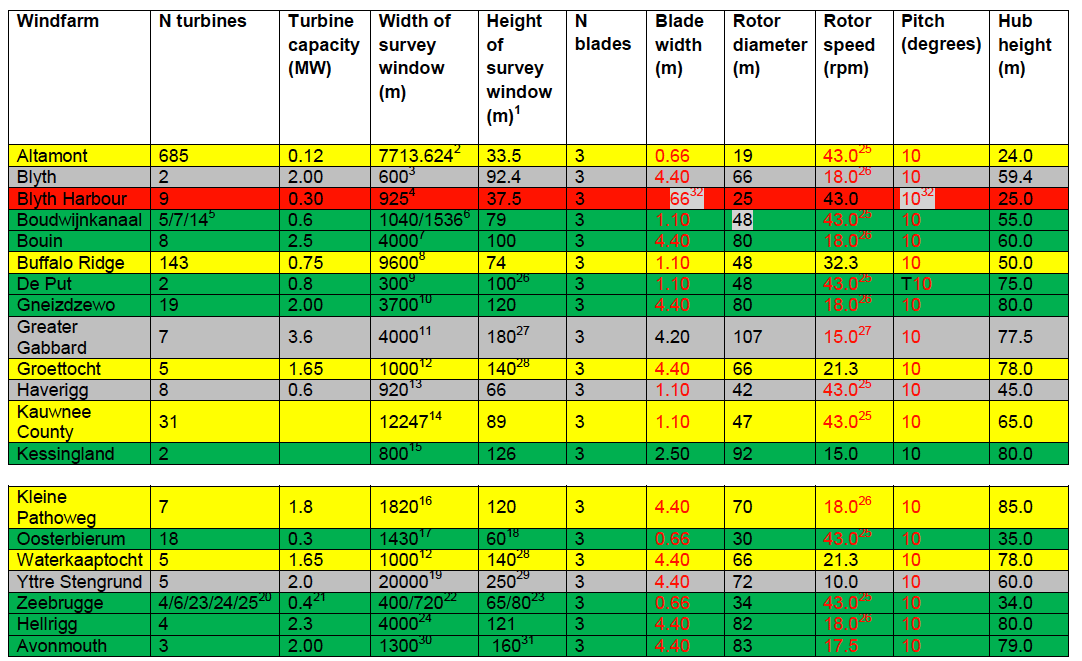
1Maximum turbine height unless otherwise stated; 2see Table 2 of Thelander et al. 2003, total survey area of 59.5 km 2, width of survey window assumed to be 59.5*1000; 3Rothery et al. (2009) state 600 m scan area; 4 Lawrence et al. (2007) state that observations were carried out between turbines 5-9, turbines separated by 200 m with a rotor diameter of 25 m and arranged in a single line; 5Collisions were recorded under all 14 turbines in 2002-2006. In 2001, bird activity surveys were carried out around five turbines and avoidance rates derived from collisions around these turbines are also presented. In 2005, bird activity surveys were carried out around seven turbines and avoidance rates derived from collisions around these turbines are also presented; 6In 2001, only five turbines were present with diameters of 48 m and spacing of 200 m, therefore, the total survey window in 2001 was 1,040 m wide (section 3.3.1 in Everaert et al. 2002, Table 27 in Everaert 2008). In 2005, 14 turbines were present, but activity was only monitored around seven of these, therefore in 2005 the total survey window was 1,536 m wide (Table 27 in Everaert 2008). Turbines were all arranged in a single line; 7Observations carried out along four 1 km linear segments on the edge of the windfarm, see section 5.1 of Dulac (2008); 8 Raptor/large bird surveys carried out through point counts at six locations, each with a radius of 0.8 km, (page 7, Johnson et al. 2000); 9Estimated from Figure 101 in Everaert (2008); 10Estimated from Google Earth map of windfarm ( https://www.google.co.uk/maps/place/Gnie%C5%BCd%C5%BCewo/@54.7467485,18.3525275,3643m/data=!3m1!1e3!4m2!3m1!1s0x46fdb3a54ca46bb1:0x5926557d4b8964d0); 11Data collected within viewing arc with a radius of 2 km, covering seven turbines (Galloper Offshore Windfarm Environmental Statement, Appendix 4); 12Data presented as number of birds/km/hr; 13Table A.3.13 in Galloper Offshore Windfarm Environmental Statement; 14Abstract of Howe et al. (2002) states that 150 km 2 were surveyed, width taken as (150)*1000; 15Birds recorded were those passing within a 200 m radius around each turbine, Wild Frontier Ecology (2013); 16Table 32 of Everaert (2008), activity monitored around turbines 3-7 which are each separated by 280 m, arranged in a single line and have a diameter of 140 m; 17Section 2.1 of Winkelman (1992), turbines have a diameter of 30 m and are 250 m apart and arranged in three lines of six turbines; 18Birds up to 60 m recorded (Tables 12a-d Winkelman 1992); 19Movements monitored over four 5 km observation lines (Figure 3, Petterson 2005); 20Based on Everaert (2008) - 23 turbines were operational and searched for corpses in 2001-2003, 25 turbines were operational and searched for corpses in 2004, and 24 turbines were operational and searched for corpses in 2005-2007. In addition, collision data for the four turbines monitored for gull activity in 2000 and 2001 (Everaert et al. 2002) and the seven turbines monitored for tern activity in 2004 and 2005 (Everaert & Stienen 2007, Everaert 2008) are also analysed in this report; 21While different turbine types have been used at Zeebrugge, the analysis in this report is based on the assumption that they share the characteristics of those on the eastern wall, where the greatest number of collisions are typically recorded (Everaert 2008); 22Gull activity was monitored along a 400 m section of the eastern wall in 2000 and 2001 (Everaert et al. 2002) and tern activity was monitored along a 720 m section of the eastern wall in 2004 and 2005 (Everaert & Stienen 2007, Everaert 2008); 23In 2000 and 2001, flight height was estimated up to a maximum of 65 m and in 2004 and 2005 flight height was estimated up to a maximum of 80 m; 24States that standard SNH vantage point methodology with radius of 2 km from a single point used (Percival 2012, 2013); 25Based on rotational speed of Blyth Harbour turbines; 26 Based on rotational speed of Enercon E-70 2.3 MW turbine; 27Similar size to Kessingland turbines; 26Birds up to 100 m recorded, see Table 37 of Everaert (2008); 27Birds up to 180 m recorded, see section 1.11 of Appendix 4; 28Radar monitoring of flight heights up to 140 m, see Krijgsveld et al. (2011); 29Flights monitored up to altitude of 250 m, see figure 11 of Petterson (2005); 30Estimated from Google Earth map of windfarm ( https://www.google.co.uk/maps/search/Bristol+Port+Wind+Park/@51.5117476,-2.7031114,1372m/data=!3m1!1e3); 31Paragraph 2.3 of The Landmark Practice (2013). 32highlighted grey so red numbering shows up against red background.
The number of birds predicted to collide with the turbines in the absence of any avoidance action can be estimated by multiplying the total number of birds predicted to pass through the rotor sweep of the turbines over the course of the time period in which collision searches were carried out by the probability of those birds colliding with the rotor blades. An avoidance rate can now be derived from these data by dividing the observed collision rate by the predicted collision rate, as in equation 6.
Avoidance rates were derived, as described above, for each species-site combination for which sufficient data were available in the studies identified as part of our literature review. The quality of data presented in each of these reports was highly variable, in particular in the level of spatial and temporal overlap between the periods over which corpses were collected and bird movement data were collected. The feasibility of collecting movement data over the course of the study periods as a whole meant that some extrapolation was inevitable when calculating avoidance rates. However, we sought to minimise this extrapolation and sought to categorise the studies we identified accordingly ( Table 5.5).
The first category (green) we identified, which we had greatest confidence in, was that in which activity data were collected at intervals throughout the period in which corpse data were collected, and from around all turbines which were searched for corpses. This meant that no spatial extrapolation was necessary to derive an avoidance rate, and the need for temporal extrapolation was minimised. The second category (yellow) we identified was similar to the first, with the exception that activity data were not collected around all of the turbines which were searched for corpses, for example at Kleine Pathoweg, where bird movements were only monitored around five of the seven turbine where corpse searches were carried out. This meant that spatial extrapolation of movement data was necessary, potentially leading to erroneous conclusions if flights were not to occur evenly throughout the site. The third category (red) also required spatial extrapolation of activity data. In addition, movement data were only collected for a portion of the time in which corpse data were collected, meaning that bird activity had to be extrapolated across seasons or years. Such extrapolation is extremely likely to give a misleading picture of the true level of bird activity at a site over the study period which is likely to vary seasonally, e.g. over breeding or migration periods. The final category (grey) relates to studies in which bird movements through windfarms have been monitored in order to directly observe collisions. Given the relative rarity of birds colliding with turbines, these studies typically have low power to detect a collision.
We consider how each of these categories influences the avoidance rates that are derived. We also consider the influence of other factors, such as turbine size, on avoidance rates in order to assess whether it is appropriate to apply avoidance rates from some of the smaller onshore turbines to the much larger turbines used in the offshore environment.
The estimation of predicted collisions requires assumptions to be made regarding the proportion of birds flying at collision risk height and their flight height distributions. Consequently, we derive avoidance rates appropriate for use with each of the three model options presented in the Band offshore collision risk model spreadsheet (Band 2012):
i. Option 1, where site specific flight height data are used to estimate the proportion of birds flying at collision risk height;
ii. Option 2, where modelled data are used to estimate the proportion of birds flying at collision risk height, based on the distributions presented in Johnston et al. (2014a) and the exact rotor dimensions presented in each report;
iii. Option 3, where modelled flight height distributions are used to account for collision risk not being distributed evenly within a turbine's rotor swept area.
It should be noted that different values would be expected for Band model options 1 and 2 because option 2 uses generic distributions from compiled data sources, which may not be directly comparable to data collected from some of the sites included in this review. In some cases, option 2 may also use a better defined risk window, as it reflects the actual turbine dimensions rather than a pre-defined window set during pre-construction surveys.
5.4.2.2 Estimating representative within-windfarm avoidance rates
The aim of this review was to derive representative within-windfarm avoidance rates that can be used to inform a total avoidance rate for use in collision risk modelling for each of the priority species. Whilst the above methodology can give us a range of different values for marine birds in general, and some of the priority species in particular, combining them to get a single, representative figure is far from straightforward. This is further complicated as several studies report no collisions, suggesting an avoidance rate of 1 over the study period. However, were the study periods of these studies to be extended indefinitely, it is likely that the avoidance rate would drop to below 1 as some individuals will always fail to take action to avoid collision, given sufficient time and bird flux within the site. Whilst one approach would be to discard studies in which no collisions were recorded, this would be inappropriate as it would risk negatively biasing our dataset and, potentially, result in a within-windfarm avoidance rate which is overly precautionary.
We identified five methodologies - ratio estimators, meta-analysis, proportional hazard models and mark-recapture models, events-trials models and Poisson regression - that could potentially be used to combine collision records and flux rates across sites in order to derive representative avoidance rates ( Table 5.6). We then considered the limitations and assumptions associated with each technique, before determining which was likely to be the most effective approach.
Meta-analysis is most appropriate when estimates of variance around effect sizes are available, which was not the case in this instance. The data available from the studies we reviewed fail basic assumptions about perfect detectability required for proportional hazard models. Similarly, as individual birds are recorded only upon their deaths, and not on their entry to the population, mark-recovery models were not appropriate. Collisions between birds and turbines are rare events. As event-trials models are most effective when the probability of an event is moderate, this methodology is also likely to be ineffective. Poisson regression models may be an effective approach. However, such an approach would require time to develop and test using simulated data. It may also be ineffective without access to raw survey data from each site. Whilst this approach may provide a useful framework for future studies it was not considered feasible within the framework of the current project.
Having considered each of the different approaches, we concluded that ratio estimators would be the most appropriate approach to combining the avoidance rate data. Given the limitations of the data, we felt that any of the more complex modelling approaches may result in undue confidence being assigned to the derived values. In the absence of raw data, we feel that any more involved modelling approach is likely to be less than robust and that, in this instance, a simpler approach, such as ratio estimators, is most appropriate.
Ratio estimators divide the total number of collisions across all sites by the total number of collisions predicted in the absence of avoidance behaviour across all sites (equation 9). By dividing the total number of collisions by the predicted collision rate, sites with greater levels of bird activity are given greater weighting than sites at which bird activity is relatively low. Arguably, this approach to weighting is more appropriate than weighting flux rate alone, as it accounts for the fact that a higher flux rate may not necessarily reflect a greater number of birds at risk of collision. For example, a site may have a relatively high flux rate, but only a relatively small proportion of these birds may be at a height which places them at risk of collision. Using equation 9, we derive representative avoidance rates for all species and groups for which sufficient data were available.

As data come from multiple sites, there is likely to be a degree of uncertainty associated with avoidance rates derived in this manner. The importance of incorporating uncertainty in the Environmental Impact Assessment process is receiving increasing recognition (Masden et al. 2014). The variance associated with the avoidance rates derived using ratio estimators can be calculated using the delta method (Powell 2007). The square root of this value will give an estimate of the standard deviation around the avoidance rates derived using ratio estimators (Batschelet 1976). It is important to note that this value will reflect variability between sites, as opposed to uncertainty in the input parameters. At present, many of the input parameters for the Band model are only available as single values ( e.g. mean rotor speed), until a realistic range of values is available for the key parameters, quantifying uncertainty from these sources will be challenging.
As we are looking for representative values for the within-windfarm avoidance rates, it is important to ensure that the values we are deriving are not unduly influenced by a single data point (each data point reflecting a single site-year-species combination), or set of data points. For this reason we investigate how different factors may influence the final avoidance rates we derive. As a first step, we explore how much influence (leverage) each data point has on the final, representative avoidance rates. We identify sites which have a high leverage and determine whether there are any common factors linking them, for example, an unusually high or low flux rate or the presence of small turbines.
We then consider how bird flux and turbine size may influence the final derived avoidance rates using a stepwise approach. These analyses are not an essential part of deriving our final avoidance rates, instead, they help us to understand how reliant our values are on the inclusion of all of our data points. Ideally, as we drop data points from our calculations, the avoidance rates derived should remain fairly constant. In the first analysis, we drop sites based on their estimated flux rates. This helps to demonstrate whether our final avoidance rate is dependent on the inclusion of data from a handful of sites with high levels of bird activity. In our second analysis, we drop sites based on maximum turbine height, to identify whether sites with smaller turbines, less typical of the offshore environment are unduly influencing the values we derive. A more detailed analysis of the sensitivity of our derived values is carried out in section 6 (below).
Table 5.6 Methodologies considered for synthesising avoidance rates across multiple data sources.
| Method |
Description |
Used |
|---|---|---|
| Ratio estimators |
Ratio estimators provide a relatively simple approach that compares the mean of the number of collisions to the mean of the number of birds at risk of collision (Cochran 1977). The approach does this by combining data across sites prior to any calculation and, therefore, accounting for the differing levels of bird activity at each site. As the number of birds at risk of collision is proportional to the bird flux at a site, this approach effectively weights sites by the level of bird activity recorded. Depending on the data available, such calculations can be undertaken on a species, group or global basis. They have the advantage of offering a single, easily interpretable output. This approach has previously been used to derive avoidance rates for geese from multiple data sources (Pendlebury 2006). |
 |
| Meta-analysis |
Meta-analysis provides a way of combining studies, which may have different uncertainties attached to them, to determine the size and statistical significance of a given effect. The units of meta-analysis are the independent results of studies, rather than the responses of individual subjects (Arnqvist & Wooster 1995), with a strong recommendation from statisticians that they should use weighted combination of effect sizes (Stewart 2010). Meta-analyses are most appropriate when studies present estimates of variance around the effect sizes (Gurevitch & Hedges 1999, Stewart 2010), which were not available from the studies we have reviewed. |
 |
| Proportional hazard models / mark-recovery models |
We considered the possibility of using time to event style models such as proportional hazard or mark-recovery models. In the case of proportional hazard models, the data fail basic assumptions about perfect detectability necessary for such analyses. As each individual bird is recorded only on its death (and not on entry to the population, i.e. when it enters the turbine space), it was not possible to use mark-recovery type models to produce synthesised ARs from the various studies. |
 |
| Events-trials models |
Events-trials models involve combining the number of events (in this case, collisions) with the number of trials (in this case, birds passing through the turbines) within a binomial generalised linear model ( GLM). However, collisions are rare events and binomial GLMs work best when the probability of an event is moderate (typically in the region of 0.2-0.8). We therefore feel such a methodology is inappropriate in this instance. |
 |
| Poisson regression |
As collisions are rare events the mean across sites is likely to be low and may be expected to follow a Poisson distribution. We could use bird flux as an offset in such a model to account for the different abundance of birds at each site and incorporate a weighting factor to account for survey effort. Zero-inflation is also likely to be an issue ( i.e. many sites record no collisions). Whilst this approach may be possible and provide a useful framework for future analyses, it would require some time to develop and test using simulated data and was thus outside of the scope of this project. It should also be noted that we are uncertain about how effective such an approach would be without access to the raw survey data from each site. |
 |
5.4.3 Results
5.4.3.1 Derived within-windfarm avoidance rates
Data combining collision rates and passage rates through windfarms were obtained from 20 sites - see Appendix 6 for details of sites and species, and Appendix 7 for full results. However, based on the available data, it was only possible to derive within-windfarm avoidance rates for eider, gulls and terns. Whilst other species had been recorded within the windfarms, these were often present in relatively low numbers, and only a single collision event, involving a flock of four eider, was observed during visual observations of turbines. The range of species reflects the onshore or coastal locations of the study sites, and it should be noted that, among the priority species being considered in this review, no estimates could be derived for northern gannet.
The range of responses estimated from the available data runs from an apparent strong attraction whereby the proportion of birds within the rotor-swept area increases by >1000% in some cases, to strong avoidance, where close to 100% of birds avoid the rotor-swept area.
Multiple years' data were collected from several onshore sites including Avonmouth and Hellrigg in the UK, Boudwijnkanaal and Zeebrugge in Belgium, Gneizdzewzo in Poland, and an offshore site at Yttre Stengrund in Sweden. Multiple years' collision data were also available from Kleine Pathoweg in Belgium. However, bird activity data were not collected concurrently with data on collision rates for this site, meaning the results cannot be used for the purposes of this review. Whilst we have been able to derive a within-windfarm avoidance rate in both study years for this site, this approach is flawed as it involves extrapolating from one year's activity data to the next. The same is true for some of the data collected for both Zeebrugge and Boudwijnkanaal. Whilst multiple years' data were also collected from sites such as Altamont Pass and Buffalo Ridge in the U.S.A. and Blyth Harbour in the UK, these data were summarised across years so it was not possible to examine year to year variation in derived avoidance rates and the resultant avoidance rates should be treated with a high degree of scepticism. Of the sites where it may be possible to compare values between years, only Hellrigg, Gneizdzewo, Boudwijnkanaal, Yttre Stengrund and Zeebrugge provide data that allow this.
We present within-windfarm avoidance rates from all sites for illustrative purposes only ( Appendix 7). For the purposes of deriving representative values, we only use what we consider to be the highest quality data (green rows in Appendix 7) where there is both spatial and temporal overlap between the collection of corpses and the collection of bird activity data. Unless otherwise stated the within-windfarm avoidance rates presented in the text from this point refer to those derived using option 1 of the Band model, but these are applicable to option 2.
In the five years for which data were available for Gneizdzewo, only a single collision involving a gull species was recorded ( Appendix 7). Similarly, in the years for which data are available from Hellrigg and Yttre Stengrund, collisions were only recorded in a single year at each site. At Boudwijnkanaal, the within-windfarm avoidance rate for herring/lesser black-backed gulls declined from 0.9903 in October 2001 to 0.9556 in October 2005. At Zeebrugge, it was possible to compare within-windfarm avoidance rates for herring and lesser black-backed gulls both between seasons and years. For herring gulls within-windfarm avoidance rates declined from 0.9861 in the 2000 breeding season to 0.9722 in the 2001 breeding season. For lesser black-backed gulls the equivalent figures were 1 in 2000 and 0.9706 in 2001. In 2001, activity data at Zeebrugge were collected in both the breeding season and autumn. The within-windfarm avoidance rates showed an increase for both species during the autumn, to 0.9976 in the case of herring gulls and 0.9990 in the case of lesser black-backed gulls. However, given the limited data available to explore these patterns, more data are required to make firm conclusions about aspects such as seasonal variation in avoidance rates.
Everaert (2014) presents within-windfarm avoidance rates for gulls derived from the same datasets for Zeebrugge, Boudwijnkanaal, Kleine Pathoweg and De Put, using the basic Band collision risk model. The results differ from those we present. The reason for this is likely to be that Everaert (2014) extrapolate bird activity data to cover broader spatial and temporal scales, whilst we focus only on the turbines and months in which bird activity data were specifically collected. The author highlights this extrapolation as a reason why his results should be treated with caution in his discussion of the results. For our purposes, we felt that focussing on the period when activity data were collected when deriving within-windfarm avoidance rates was more consistent with our approach at other sites. A similar issue has been raised in the past in relation to Sandwich tern within-windfarm avoidance rates derived from collision data at Zeebrugge, where rates derived from the same dataset have varied from 0.9664-0.9955 (see NE/ JNCC note on subject). This highlights the importance of transparency in the calculations used to derive within-windfarm avoidance rates, enabling people to understand why differences may have arisen and come to an informed position about which values are likely to be most applicable to the situation at hand.
Our analyses of the tern data from Zeebrugge suggest that within-windfarm avoidance rates are likely to be towards the high point of this range. Using only collisions reported in June and around the seven turbines from which activity data were collected, we estimated a within-windfarm avoidance rate of 0.9944 for common tern in 2004 and 0.9948 in 2005. For Sandwich tern, we estimated within-windfarm avoidance rates of 0.9980 in 2004 and 0.9989 in 2005. No collisions involving little terns were recorded around these turbines in either year. These data suggest that tern within-windfarm avoidance rates are very high, and may be consistent year on year.
In addition to estimating collision rates from fatality searches, at four sites - Blyth Offshore Windfarm, Greater Gabbard Offshore Windfarm, Haverigg Windfarm and the Yttre Stengrund and Utgrunden Offshore Windfarms in Sweden - bird activity has been monitored with a view to directly observing collisions. In total, 646 hours of observations have been collected in this manner across the four sites and five windfarms. These surveys documented 3,167,238 bird movements within-windfarms, including at least 5,319 involving gulls. Despite this, these had relatively low power to detect a collision. In the absence of avoidance action, across these sites only 63 collisions would have been expected based on the basic Band model and only 45 based on the extended Band model ( Appendix 7). In relation to the priority species covered by this report, 17 of the collisions predicted using the basic Band model and 13 predicted using the extended Band model would have involved gulls. A single collision involving a gull would reflect an avoidance rate of less than 0.95 for both the basic and extended Band model. Such an avoidance rate would be extremely conservative, and it is therefore, unsurprising that no collisions were recorded during visual observations. Indeed, over the course of these studies, only a single collision event, involving four common eider at a single turbine at Yttre Stengrund Offshore Windfarm was observed, reflecting a within-windfarm avoidance rate of 0.1861 for common eider in autumn 2003 or 0.9024 across all seasons and years. Consequently these studies do not provide strong evidence for the behavioural response of our five priority species to turbines.
Deriving within-windfarm avoidance rates using the different Band model options
Whilst the observed number of collisions remains constant, regardless of the model option used, the predicted number of birds at risk of collision varies. As avoidance rates are derived by dividing observed collisions by predicted collisions (eq. 6), avoidance rates derived using different model options will vary. Collision estimates produced using the different Band model options and option-specific avoidance rates will only be identical if the windfarm in question has the same specifications as used to derive those avoidance rates. However, this will not be the case when these avoidance rates are applied to a novel site as a result of differences in model input parameters ( e.g. turbine specifications and site-specific estimates of the proportion of birds at collision risk height).
Within-windfarm avoidance rates derived using option 1 of the Band model are higher than those derived using options 2 and 3. The difference in values derived using option 1 and option 2 results from the use of site-specific data on the proportion of birds at risk in option 1, and the use of a generic flight height distribution to inform the proportion of birds at risk in option 2 - in other respects these options are mathematically identical. The difference between option 2 and option 3 lies in how the flux rate and probability of collision are applied across the turbines rotor-swept area. Using option 2, an average collision probability is multiplied by an average flux rate. This introduces error when a species' flight height distribution is not uniform. Option 3 accounts for the non-uniform flight height distribution, common to many species (Johnston et al. 2014a), by integrating the flux rate and collision probability over the turbines' rotor-swept area.
5.4.3.2 Representative within-windfarm avoidance rates
The within-windfarm avoidance rates data described above, and presented in Appendix 7 are of extremely variable quality. The final, derived within-windfarm avoidance rates are heavily dependent on the accuracy of the estimated flux rates at each site and on the accuracy of collision estimates. As continuous monitoring of bird activity at these sites was not feasible, some degree of extrapolation to estimate the total flux rate will be inevitable. However, it is desirable to keep this extrapolation to a minimum. For this reason, we only combine data from sites at which it was not necessary to make a spatial extrapolation in order to estimate a flux rate, and for which activity data were collected at intervals throughout the period in which collisions were monitored, to minimise the potential for inappropriate temporal extrapolation. The sites meeting these criteria were Avonmouth (Winter 2007/08, 2008/09, 2009/10, 2011/12), Boudwijnkanaal (October 2001 and October 2005), Bouin, De Put, Gneizdzewo (autumn 2007, 2008, 2009, 2010, 2011, 2012), Hellrigg (winter 2011, 2012), Kessingland, Oosterbierum (autumn 1990, spring 1991) and Zeebrugge (June-July 2000, June-July 2001 and September-October 2001). All of these sites were located onshore.
Across these sites, a total of 3,880,794 seabirds, of which the majority (66%) were gulls, were expected to have passed through the windfarms over the periods in which corpse searches were carried out. We determined that sufficient data were available to derive avoidance rates for four species - black-headed gull, common gull, lesser black-backed gull and herring gull - and four species groups - all gulls, large gulls (lesser black-backed gull, herring gull, great black-backed gull, Caspian gull, yellow-legged gull), small gulls (black-headed gull, common gull, little gull) and all terns.
Black-headed gull
A total of 746,668 black-headed gulls were expected to have passed through seven sites - Avonmouth (four studies), Boudwijnkanaal (one study), Bouin (one study), Gneizdzewo (three studies), Hellrigg (two studies), Kessingland (one study) and Zeebrugge (three studies) - over the course of their respective study periods. After adjustments were made to this total to account for the proportion of birds flying at rotor height, the size of the rotor swept area and the probability of birds passing through the rotor-swept area without colliding, this was predicted to result in 1,839 collisions based on option 1 and 582 collisions based on option 2, and 297 based on option 3. However, in total only 38 black-headed gull collisions were recorded across all sites during their respective study periods. This corresponds to within-windfarm avoidance rates of 0.9795 (± 0.0033 SD) using option 1 of the Band model, 0.9351 (± 0.0031 SD) using option 2 of the Band model and 0.8731 (± 0.0056 SD) using option 3 of the Band model.
We investigated the leverage that each study site had on the final within-windfarm avoidance rates derived for black-headed gull. We identified three sites which had high leverage for the within-windfarm avoidance rates derived using options 1 and/or 2 and/or 3 of the Band model ( Figure 5.1). Of these, the exclusion of data from Bouin resulted in an increase in the value derived using option 1. This is likely to be due to the presence of the turbines on the edge of a black-headed gull breeding colony. This may have led to a greater number of flights through the rotor-swept area of turbines by adult birds returning to provision chicks and/or newly fledged chicks less experienced at flying. As a result of the relatively high collision rate at this site, including this site in our analysis reduced the overall within-windfarm avoidance rate derived using option 1. The leverage of data from Hellrigg in 2012/13 was of a similar magnitude, but in the opposite direction. Despite having the highest level of black-headed gull activity and a high proportion of birds flying at collision risk height, no collisions were recorded at this site, in this year. As a consequence, excluding these data from our analysis resulted in a reduction in the overall within-windfarm avoidance rate.
In contrast to option 1, the exclusion of data from Bouin led to a substantial decrease in the overall within-windfarm avoidance rates derived using options 2 and 3. The relative importance of data from Bouin is exaggerated using options 2 and 3 of the Band model as modelled flight height distributions suggest that other sites with high levels of bird activity, such as Hellrigg, should have very low proportions of birds flying at collision risk height. As such, the predicted collision rates at these sites are much lower than when using option 1 and they have much less influence when used to derive overall within-windfarm avoidance rates using ratio estimators. In addition, the within-windfarm avoidance rates derived for Bouin using options 2 and 3 are significantly higher than for other sites at which collisions were recorded meaning, given its importance relative to other sites, excluding data from Bouin from the analysis results in a significant decrease in the overall within-windfarm avoidance rate derived. Excluding data from Boudwijnkanaal from the analysis for options 2 and 3 results in an increase in the overall within-windfarm avoidance rate. As with Bouin, a relatively high number of collisions were recorded at this site. However, as observed data suggest a high proportion (69%) of birds flew at collision risk height, this site did not have particularly high leverage for the within-windfarm avoidance rates derived. However, using options 2 and 3, only 4.5% of birds were predicted to fly at collision risk height, meaning the final within-windfarm avoidance rate derived for this site was relatively low.
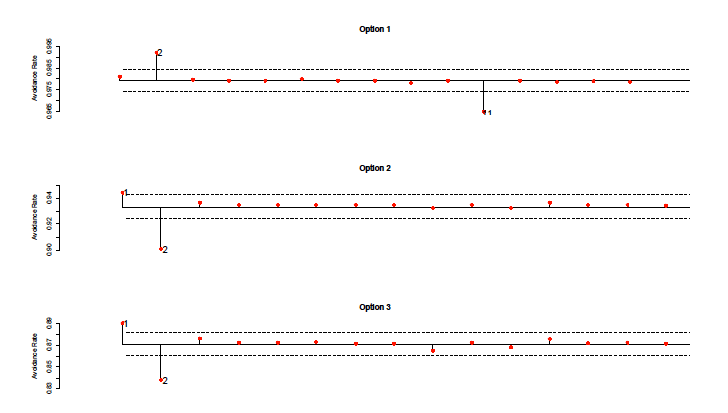
Figure 5.1 Leverage exerted by each site at which within-windfarm avoidance rates were calculated on the overall, mean within-windfarm avoidance rate derived for black-headed gull. Solid line indicates mean within-windfarm avoidance rate across all sites, broken line indicates mean within-windfarm avoidance rate across all sites ± 1 standard deviation, dots indicate mean within-windfarm avoidance rate with each site excluded from analysis. Sites are considered to have high leverage when their exclusion from the analysis leads to a change of more than 1 standard deviation in the overall mean within-windfarm avoidance rate. Sites with high leverage are: 1 - Boudwijnkanaal, 2 - Bouin and 11 - Hellrigg in 2012/13.
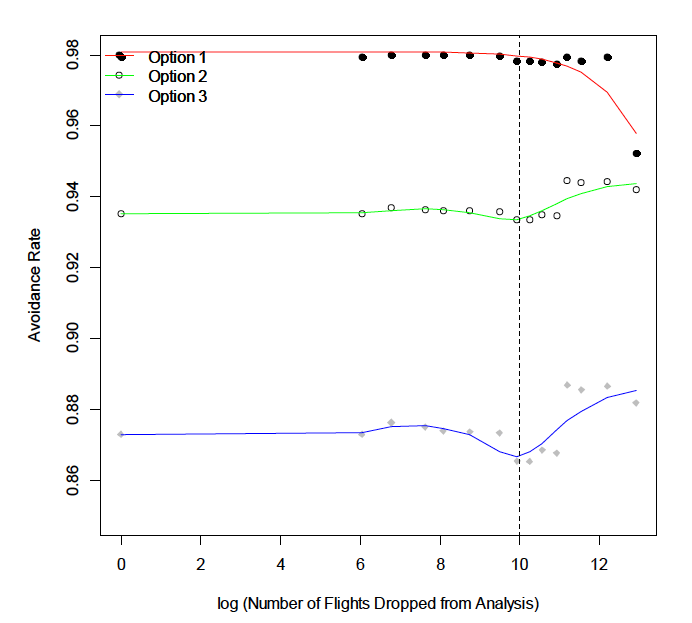
Figure 5.2 Impact of dropping data points (each site-year-species combination) on the within-windfarm avoidance rates derived using ratio estimators for options 1, 2 and 3 of the Band model for black-headed gull.
As might be expected, dropping sites from the analysis can influence the final within-windfarm avoidance rates. Only sites at which there is a relatively limited level of flight activity can be dropped from the analysis before the within-windfarm avoidance rates derived become less stable ( Figure 5.1). In all three model options, this is noticeable after around 22,000 of the 746,668 flights through the windfarms have been removed ( Figure 5.2).
Using option 1 of the Band model, the derived within-windfarm avoidance rate remains relatively stable at around 0.9795 until Bouin is the only site remaining in the analysis at which point it drops to around 0.9370. As discussed previously, this may reflect the fact that Bouin is located on the edge of a black-headed gull breeding colony, resulting in a higher number of collisions than were recorded elsewhere. In contrast, using options 2 and 3, within-windfarm avoidance rates start to increase after the first 22,000 flights have been dropped. Again, as discussed previously, this is likely to reflect the fact far fewer collisions were predicted at several key sites due to differences in the predicted proportions of birds at collision risk height. As a consequence, as more sites are dropped from the analysis the influence of Bouin, previously identified as having a strong influence on the final derived values for options 2 and 3, becomes stronger.
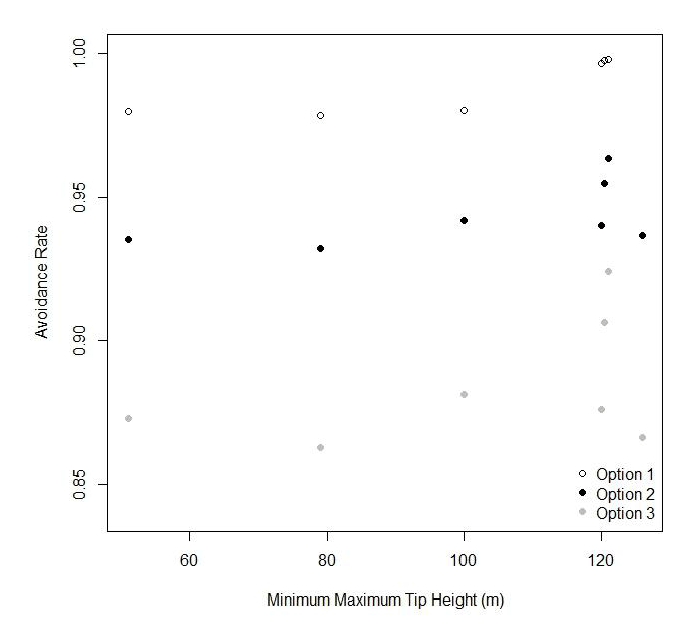
Figure 5.3 Impact of excluding sites with smaller turbines on the within-windfarm avoidance rates derived using ratio estimators for options 1, 2 and 3 of the Band model for black-headed gull.
The inclusion of sites with smaller turbines did not appear to strongly influence the final within-windfarm avoidance rates derived for black-headed gull using any of the three model options ( Figure 5.3).
We consider within-windfarm avoidance rates of 0.9795 (± 0.0033 SD) for the basic Band model, and 0.8731 (± 0.0056 SD) for the extended Band model to be realistic, precautionary values given the data available. Whilst we identified several sites as having a strong influence over the final values derived, we do not feel there is sufficient reason to exclude these data from our analysis. It should be noted that the influence of these sites occurs in similar magnitudes in both positive and negative directions. The within-windfarm avoidance rates derived, especially for option 1, remain relatively stable regardless of which sites are included in the analysis. We did not identify any strong impact of turbine size on the final within-windfarm avoidance rate derived.
Common gull
A total of 841,008 common gulls were expected to have passed through three sites - Gneizdzewo (three studies), Kessingland (one study) and Hellrigg (two studies) - over the course of their respective study periods. After adjustments were made to this total to account for the proportion of birds flying at rotor height, the size of the rotor swept area and the probability of birds passing through the rotor-swept area without colliding, this was predicted to result in 3,405 collisions based on option 1 and 218 collisions based on option 2, and 129 based on option 3. However, in total only two common gull collisions were recorded across all sites during their respective study periods. This corresponds to within-windfarm avoidance rates of 0.9995 (± 0.0003 SD) using option 1 of the Band model, 0.9918 (± 0.0046 SD) using option 2 of the Band model and 0.9861 (± 0.0078 SD) using option 3 of the Band model.
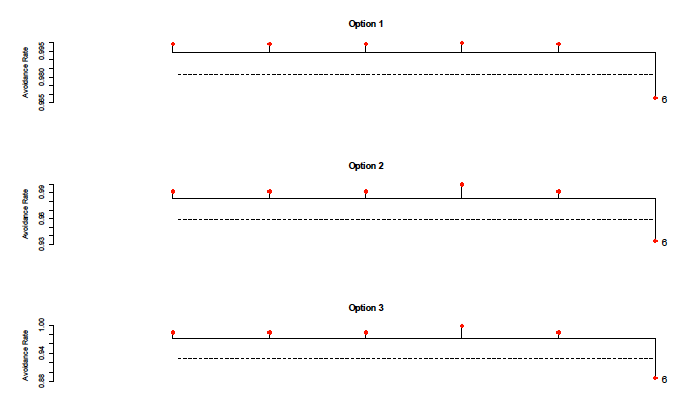
Figure 5.4 Leverage exerted by each site at which within-windfarm avoidance rates were calculated on the overall, mean within-windfarm avoidance rate derived for common gull. Solid line indicates mean within-windfarm avoidance rate across all sites, broken line indicates mean within-windfarm avoidance rate across all sites ± standard deviation, dots indicate mean within-windfarm avoidance rate with each site excluded from analysis. Sites are considered to have high leverage when their exclusion from the analysis leads to a change of more than 1 standard deviation in the overall mean within-windfarm avoidance rate. Site with high leverage is 6 - Hellrigg in 2012/13.
For all three model options, Hellrigg in 2012/13 appears to have a strong influence over the final within-windfarm avoidance rate derived ( Figure 5.4). This is likely to reflect the fact that of the total number of common gulls estimated to have flown through windfarms, over 94% were estimated to have flown through Hellrigg in this year. Despite this, no collisions were recorded involving common gulls at Hellrigg in 2012/13. As a result, excluding these data from our analyses results in an overall within-windfarm avoidance rate of 0.9680 for option 1 of the Band model, 0.9345 for option 2 of the Band model and 0.8865 for option 3 of the Band model. However, we do not feel it would be appropriate to exclude such a substantial portion of our data from the analysis in this way.
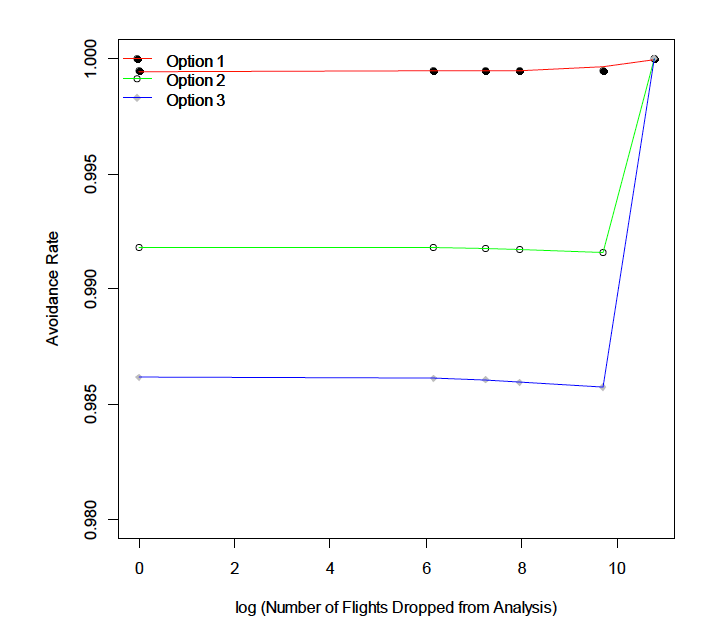
Figure 5.5 Impact of dropping data points (each site-year-species combination) on the within-windfarm avoidance rates derived using ratio estimators for options 1, 2 and 3 of the Band model for common gull.
For all three model options, the within-windfarm avoidance rate derived using ratio estimators remains stable until the only site remaining in the analysis is Hellrigg in 2012/13 ( Figure 5.5). As stated above, this is likely to reflect the extremely high leverage of this data point.
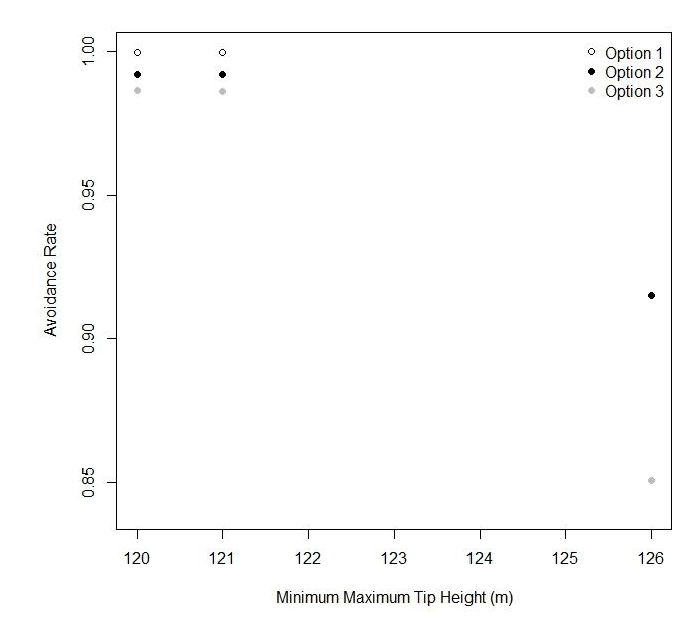
Figure 5.6 Impact of excluding sites with smaller turbines on the within-windfarm avoidance rates derived using ratio estimators for options 1, 2 and 3 of the Band model for common gull.
Maximum tip height appeared to influence the within-windfarm avoidance rates reported, with lower within-windfarm avoidance rates associated with the tallest turbines ( Figure 5.6). In reality, this is likely to reflect the fact that collisions were only recorded at Kessingland, the site with the largest turbines, and may, therefore, be coincidence.
Whilst data from Hellrigg in 2012/13 have strong leverage, this must be considered in the context of the sheer number of flights that were estimated at the site in that year, and in combination with the fact that collisions involving common gulls were only recorded at one of the three study sites in a single year. We therefore feel that within-windfarm avoidance rates of 0.9995 (± 0.0003 SD) for the basic Band model and 0.9861 (± 0.0078 SD) for the extended Band model are likely to reflect realistic, precautionary within-windfarm avoidance rates for common gulls. Whilst we feel there is no valid reason to exclude the data from Hellrigg in 2012/13 from our analyses, we feel that its high leverage means that the final within-windfarm avoidance rates derived must be treated with caution.
Herring gull
A total of 526,047 herring gulls were expected to have passed through seven sites - Avonmouth (four studies), Boudwijnkanaal (one study), Bouin (one study), Gneizdzewo (one study), Hellrigg (two studies), Kessingland (one study), Zeebrugge (three studies) - over the course of their respective study periods. After adjustments were made to this total to account for the proportion of birds flying at rotor height, the size of the rotor swept area and the probability of birds passing through the rotor-swept area without colliding, this was predicted to result in 2,157 collisions based on option 1, 1,147 collisions based on option 2, and 957 based on option 3. However, in total only nine herring gull collisions were recorded across all sites during their respective study periods. This corresponds to within-windfarm avoidance rates of 0.9959 (±0.0006 SD) using option 1 of the Band model, 0.9924 (±0.0010 SD) using option 2 of the Band model and 0.9908 (±0.0012 SD) using option 3 of the Band model.
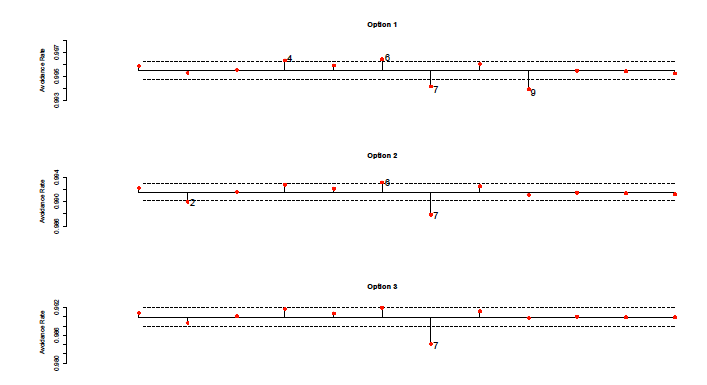
Figure 5.7 Leverage exerted by each site at which within-windfarm avoidance rates were calculated on the overall, mean within-windfarm avoidance rate derived for herring gull. Solid line indicates mean within-windfarm avoidance rate across all sites, broken line indicates mean within-windfarm avoidance rate across all sites ± 1 standard deviation, dots indicate mean within-windfarm avoidance rate with each site excluded from analysis. Sites are considered to have high leverage when their exclusion from the analysis leads to a change of more than 1 standard deviation in the overall mean within-windfarm avoidance rate. Sites with high leverage are 2 - Bouin, 4 - Kessingland, 6 - Zeebrugge (June-July 2001), 7 - Zeebrugge (September-October 2001) and 9 - Hellrigg (2012/13).
No obvious patterns were evident amongst the sites with high leverage ( Figure 5.7). The exclusion of data from Kessingland and Zeebrugge (June-July 2001) from the analysis led to an increase in the overall within-windfarm avoidance rates as both these sites recorded two collisions over the course of their respective study periods. Whilst these were amongst the highest collision rates at the sites we considered, there is no evidence that turbine size played a role. Whilst the turbines at Zeebrugge were the smallest among our study sites, those at Kessingland were the largest. The exclusion of Hellrigg (2012/13) and Zeebrugge (September-October 2001) led to a decrease in the overall within-windfarm avoidance rates. This is likely to reflect the fact that whilst these data points represented the greatest numbers of birds passing through the sites, only two collisions were recorded at Zeebrugge (September-October 2001). It is worth noting that the magnitude of the effect of removing data from Zeebrugge was similar whether data from June-July 2001 or September-October 2001 were removed, although the effect was in opposing directions. Based on these analyses, we did not feel it was appropriate to exclude any data points from our analysis when deriving an overall within-windfarm avoidance rate for herring gull.
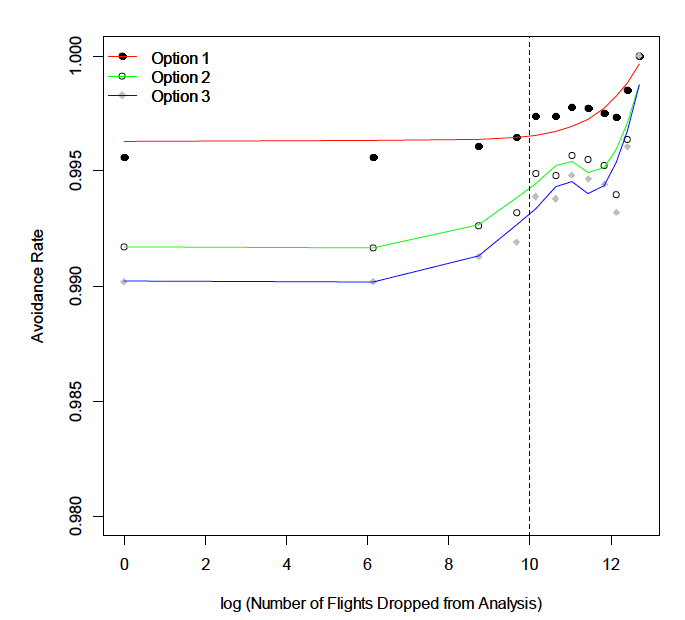
Figure 5.8 Impact of dropping data points (each site-year-species combination) on the within-windfarm avoidance rates derived using ratio estimators for options 1, 2 and 3 of the Band model for herring gull.
Dropping sites with lower levels of flight activity leads to an increase in the within-windfarm avoidance rates derived for herring gull using all three model options ( Figure 5.8). Whilst ideally, within-windfarm avoidance rates would remain stable, regardless of the number of flights included in the analysis, it does suggest that the rates derived using the full dataset may be realistic, precautionary values.
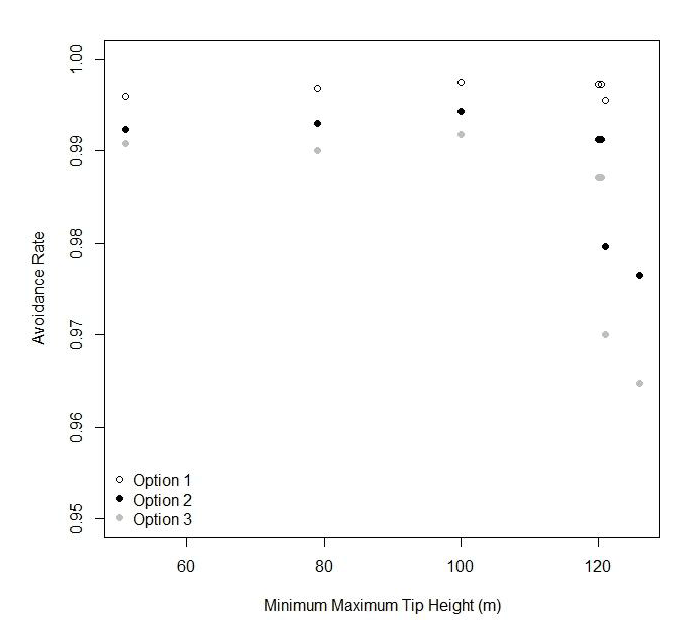
Figure 5.9 Impact of excluding sites with smaller turbines on the within-windfarm avoidance rates derived using ratio estimators for options 1, 2 and 3 of the Band model for herring gull.
Using option 1 of the Band model, there does not appear to be a relationship between turbine size and the within-windfarm avoidance rates derived using ratio estimators ( Figure 5.9). However, in the case of options 2 and 3, there is a trend for lower within-windfarm avoidance rates with larger turbines. This apparent discrepancy is likely to reflect differences between the proportion of birds observed flying at collision risk height and the proportion of birds estimated to fly at collision risk height from generic distributions. The generic distributions estimated a lower proportion of birds flying at collision risk height for the larger turbines, meaning the predicted collision rate, and therefore overall within-windfarm avoidance rate, was reduced.
We consider within-windfarm avoidance rates of 0.9959 (±0.0006 SD) for the basic Band model, and 0.9908 (±0.0012 SD) for the extended Band model to be realistic, precautionary values given the data available. Whilst we identified several sites as having a strong influence over the final values derived, we do not feel there is sufficient reason to exclude these data from our analysis. It should be noted that the influence of these sites occurs in similar magnitudes in both positive and negative directions. We did not identify any strong impact of turbine size on the final within-windfarm avoidance rate derived.
Lesser black-backed gull
A total of 101,745 lesser black-backed gulls were expected to have passed through three sites - Hellrigg (two studies), Kessingland (one study) and Zeebrugge (three studies) - over the course of their respective study periods. After adjustments were made to this total to account for the proportion of birds flying at rotor height, the size of the rotor swept area and the probability of birds passing through the rotor-swept area without colliding, this was predicted to result in 1,110 collisions based on option 1,512 collisions based on option 2, and 473 based on option 3. However, in total only two lesser black-backed gull collisions were recorded across all sites during their respective study periods. This corresponds to within-windfarm avoidance rates of 0.9982 (±0.0005 SD) using option 1 of the Band model, 0.9960 (±0.0010 SD) using option 2 of the Band model and 0.9957 (±0.0011 SD) using option 3 of the Band model.
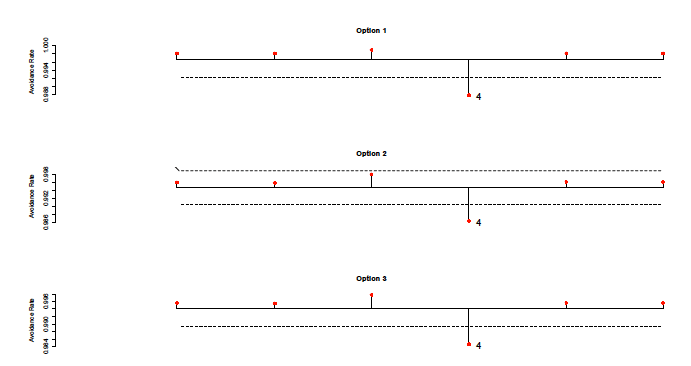
Figure 5.10 Leverage exerted by each site at which within-windfarm avoidance rates were calculated on the overall, mean within-windfarm avoidance rate derived for lesser black-backed gull. Solid line indicates mean within-windfarm avoidance rate across all sites, broken line indicates mean within-windfarm avoidance rate across all sites ± 1 standard deviation, dots indicate mean within-windfarm avoidance rate with each site excluded from analysis. Sites are considered to have high leverage when their exclusion from the analysis leads to a change of more than 1 standard deviation in the overall mean within-windfarm avoidance rate. Site with high leverage is 4 - Zeebrugge (September-October 2001).
Data from all three model options indicated that Zeebrugge in September-October 2001 had a relatively high leverage on the final within-windfarm avoidance rates derived using ratio estimators ( Figure 5.10). This is likely to reflect the fact that Zeebrugge in September-October 2001 had the highest levels of bird activity by some distance. Despite this, only a single collision was recorded over the study period. Excluding these data from the analysis results in within-windfarm avoidance rates of 0.9878 using option 1, 0.9865 using option 2 and 0.9847 using option 3. However, we do not feel it is appropriate to exclude data in this way.
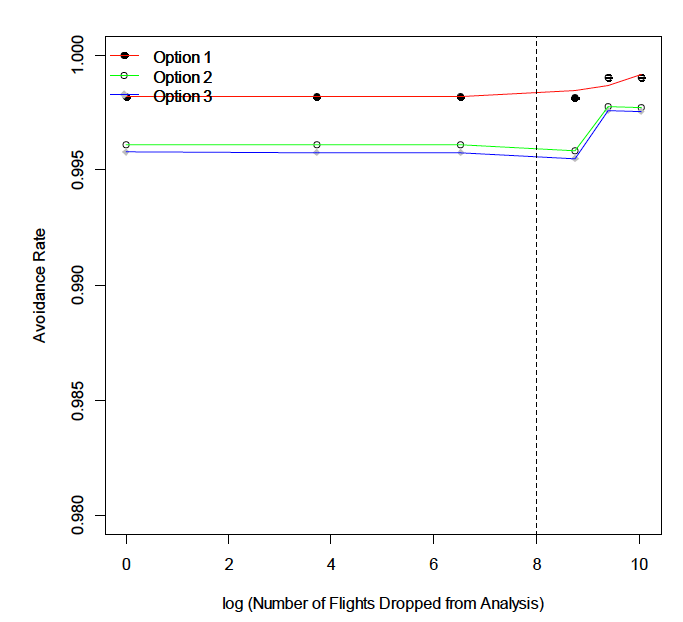
Figure 5.11 Impact of dropping data points (each site-year-species combination) on the within-windfarm avoidance rates derived using ratio estimators for options 1, 2 and 3 of the Band model for lesser black-backed gull.
Using option 1 of the Band model to derive within-windfarm avoidance rates, values remain fairly stable regardless of the number of birds recorded flying through the study sites ( Figure 5.11). Using options 2 and 3 the final value remains relatively stable until the first 6,000 flights have been removed. This is likely to reflect that fact that whilst a relatively high number of birds were predicted to have flown through the final two sites, only a single collision was recorded.
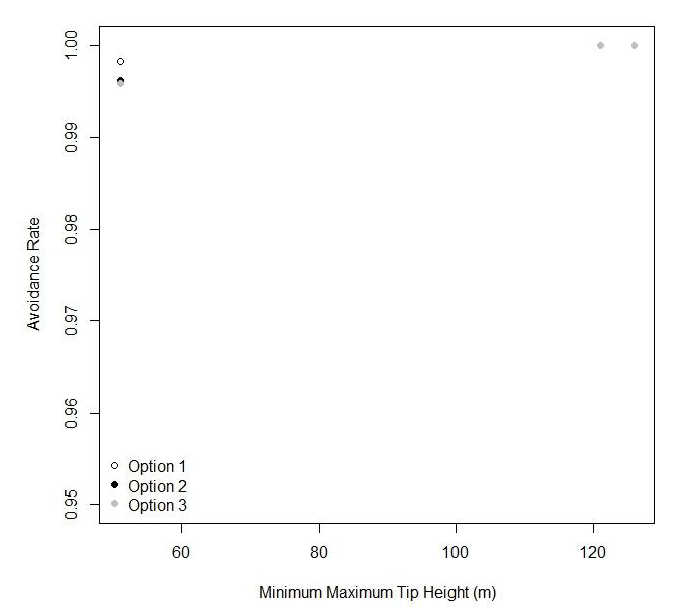
Figure 5.12 Impact of excluding sites with smaller turbines on the within-windfarm avoidance rates derived using ratio estimators for options 1, 2 and 3 of the Band model for lesser black-backed gull.
Excluding smaller turbines did not appear to have a significant impact on the final within-windfarm avoidance rate derived for lesser black-backed gull using any of the three model options ( Figure 5.12).
Whilst data from Zeebrugge in September-October 2001 had a relatively high leverage on the final within-windfarm avoidance rates derived, we did not feel there was a compelling reason to exclude these data from our analysis. Based on the data available for lesser black-backed gull, we consider within-windfarm avoidance rates of 0.9982 (±0.0005 SD) for the basic Band model and 0.9957 (±0.0011 SD) for the extended Band model to be realistic, precautionary values given the data available. However, given the data come from only three sites and incorporate a relatively small number of flights through the windfarm, we feel these values should be treated with caution. Whilst we identified several sites as having a strong influence over the final values derived, we do not feel there is sufficient reason to exclude these data from our analysis. It should be noted that the influence of these sites occurs in similar magnitudes in both positive and negative directions. We did not identify any strong impact of turbine size on the final within-windfarm avoidance rate derived.
Small gulls
A total of 1,589,953 small gulls were expected to have passed through eight sites over the course of their respective study periods. After adjustments were made to this total to account for the proportion of birds flying at rotor height, the size of the rotor swept area and the probability of birds passing through the rotor-swept area without colliding, this was predicted to result in 5,263 collisions based on option 1,801 collisions based on option 2, and 427 based on option 3. However, in total only 42 small gull collisions were recorded across all sites during their respective study periods. This corresponds to within-windfarm avoidance rates of 0.9921 (±0.0015 SD) using option 1 of the Band model, 0.9481 (±0.0032 SD) using option 2 of the Band model and 0.9027 (±0.0068 SD) using option 3 of the Band model.
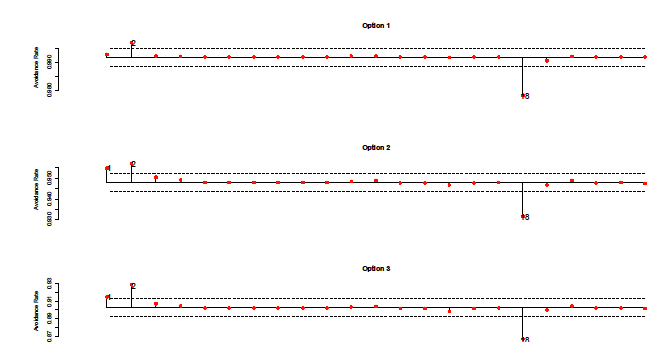
Figure 5.13 Leverage exerted by each site at which within-windfarm avoidance rates were calculated on the overall, mean within-windfarm avoidance rate derived for small gulls. Solid line indicates mean within-windfarm avoidance rate across all sites, broken line indicates mean within-windfarm avoidance rate across all sites ± 1 standard deviation, dots indicate mean within-windfarm avoidance rate with each site excluded from analysis. Sites are considered to have high leverage when their exclusion from the analysis leads to a change of more than 1 standard deviation in the overall mean within-windfarm avoidance rate. Sites with high leverage are 1 - black-headed gull at Boudwijnkanaal in October 2015, 2 - black-headed gull at Bouin and 18 - common gull at Hellrigg in 2012/13.
For all three model options, the exclusion of data from black-headed gull at Bouin results in an increased within-windfarm avoidance rate ( Figure 5.13). This is likely to be due to the presence of the turbines on the edge of a black-headed gull breeding colony. This may have led to a greater number of flights through the rotor-swept area of turbines by adult birds returning to provision chicks and/or newly fledged chicks less experienced at flying. As a result of the relatively high collision rate, including this site in our analysis reduced the overall rate derived using option 1. The leverage of data from Hellrigg in 2012/13 was of a similar magnitude, but in the opposite direction. Despite having the highest level of small gull activity and a high proportion of birds flying at collision risk height, no collisions were recorded at this site, in this year. However, we did not consider there to be a valid reason for excluding these sites from our analysis.
Using options 2 and 3, excluding data for black-headed gull from Boudwijnkanaal in October 2005 also resulted in an increase in the overall within-windfarm avoidance rates. The reason for this differing from the results for option 1 is that the modelled flight height distribution predicts a lower proportion of birds at collision risk height. As a consequence, the predicted collision rate, and therefore the within-windfarm avoidance rate, is reduced.
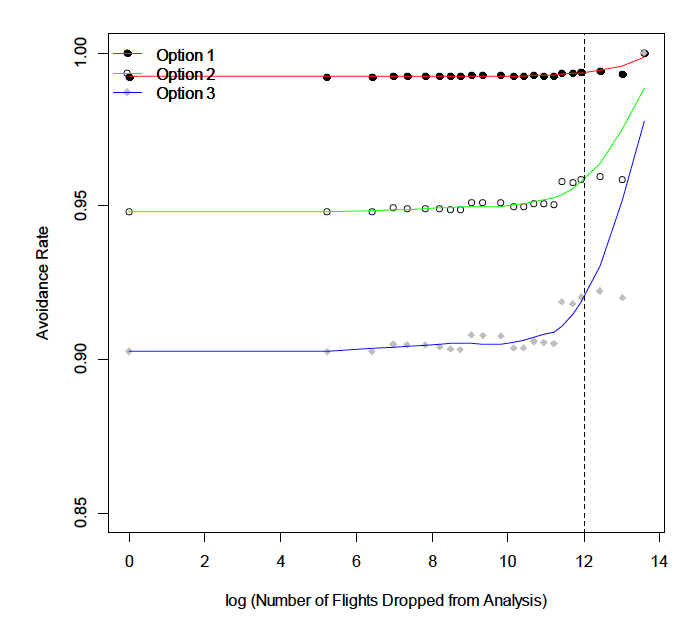
Figure 5.14 Impact of dropping data points (each site-year-species combination) on the within-windfarm avoidance rates derived using ratio estimators for options 1, 2 and 3 of the Band model for small gulls.
Within-windfarm avoidance rates derived using all three model options remain relatively stable as the first 160,000 flights through windfarms were dropped from the analysis (Figure 5.14), before increasing as only the sites with the highest levels of gull activity remain. This reflects the fact that at several of the sites with the highest levels of gull activity, no collisions were recorded, resulting in an overall increase in the within-windfarm avoidance rates as other sites were dropped.
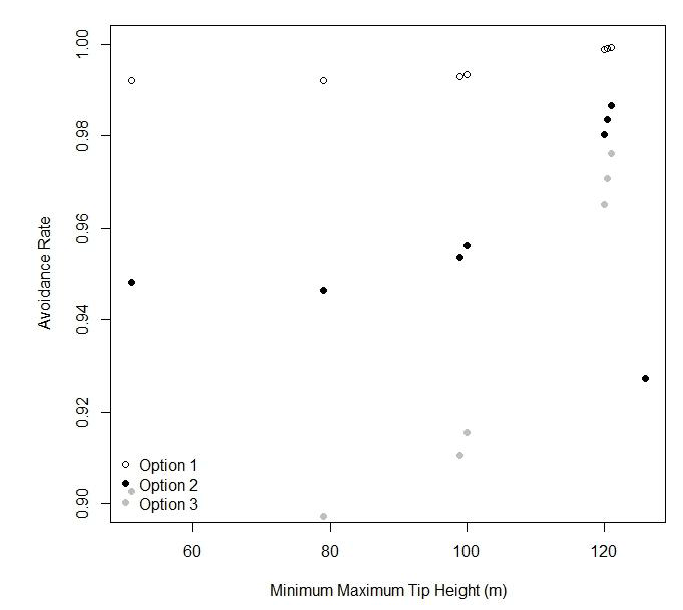
Figure 5.15 Impact of excluding sites with smaller turbines on the within-windfarm avoidance rates derived using ratio estimators for options 1, 2 and 3 of the Band model for small gulls.
Using option 1 of the Band model, there does not appear to be a relationship between turbine size and the within-windfarm avoidance rates derived using ratio estimators ( Figure 5.15). However, in the case of options 2 and 3, there is a trend for higher within-windfarm avoidance rates with larger turbines. The reason for this discrepancy is unclear, although it may reflect differences in the proportion of birds at collision risk height between the observed data and modelled distributions.
We consider within-windfarm avoidance rates of 0.9921 (±0.0015 SD) for the basic Band model, and 0.9027 (±0.0068 SD) for the extended Band model to be realistic, precautionary values given the data available. Whilst we identified several sites as having a strong influence over the final values derived, we do not feel there is sufficient reason to exclude these data from our analysis. It should be noted that the influence of these sites occurs in similar magnitudes in both positive and negative directions. We did not identify any strong impact of turbine size on the final within-windfarm avoidance rate derived using option 1 of the Band model.
Large gulls
A total of 639,560 large gulls were expected to have passed through seven sites - Avonmouth (four studies, one species), Boudwijnkanaal (two studies, two species), Bouin (one study, one species), Gniezdzewo (three studies, three species), Hellrigg (three studies, three species), Kessingland (one study, three species) and Zeebrugge (three studies, two species) - over the course of their respective study periods. After adjustments were made to this total to account for the proportion of birds flying at rotor height, the size of the rotor swept area and the probability of birds passing through the rotor-swept area without colliding, this was predicted to result in 3,368 collisions based on option 1, 1,684 collisions based on option 2, and 1,452 based on option 3. However, in total only 42 large gull collisions were recorded across all sites during their respective study periods. This corresponds to within-windfarm avoidance rates of 0.9956 (±0.0004 SD) using option 1 of the Band model, 0.9912 (±0.0007 SD) using option 2 of the Band model and 0.9898 (±0.0009 SD) using option 3 of the Band model.
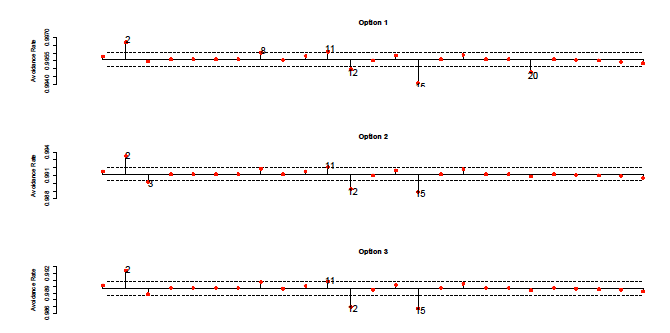
Figure 5.16 Leverage exerted by each site at which within-windfarm avoidance rates were calculated on the overall, mean within-windfarm avoidance rate derived for large gulls. Solid line indicates mean within-windfarm avoidance rate across all sites, broken line indicates mean within-windfarm avoidance rate across all sites ± 1 standard deviation, dots indicate mean within-windfarm avoidance rate with each site excluded from analysis. Sites are considered to have high leverage when their exclusion from the analysis leads to a change of more than 1 standard deviation in the overall mean within-windfarm avoidance rate. Sites with high leverage are 2 - herring/lesser black-backed gull, Boudwijnkanaal (October 2005), 3 - herring gull, Bouin; 8 - herring gull, Kessingland; 11 - herring gull, Zeebrugge (June-July 2001); 12 - herring gull, Zeebrugge (September-October 2001); 15 - lesser black-backed gull, Zeebrugge (September-October 2001); and 20 - herring gull, Hellrigg (2012/13).
There is no obvious pattern to the sites which have high leverage over the final derived within-windfarm avoidance rates ( Figure 5.16). Excluding the data for herring/lesser black-backed gull at Boudwijnkanaal in October 2005, herring gull for Kessingland and herring gull for Zeebrugge in June-July 2001 results in an increase in the overall within-windfarm avoidance rate. The size of turbines at these sites varies from small (51 m maximum turbine height at Zeebrugge) to large (126 m maximum turbine height at Kessingland) so the inclusion of different sizes of turbines does not appear to have influenced the within-windfarm avoidance rates derived. In contrast, the inclusion of date for herring gull and lesser black-backed gull at Zeebrugge in September-October 2001 and for herring gull at Hellrigg in 2012/13 results in an increase in the overall within-windfarm avoidance rate derived. In these cases, the increase in the within-windfarm avoidance rates is likely to be linked to the relatively high activity levels at these sites and relatively low collision rates. We do not consider there to be a valid reason for excluding these sites from the analysis.
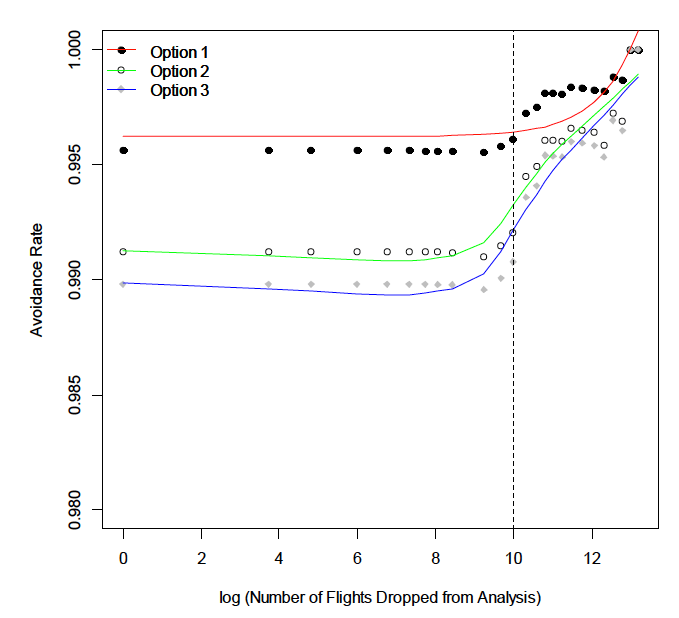
Figure 5.17 Impact of dropping data points (each site-year-species combination) on the within-windfarm avoidance rates derived using ratio estimators for options 1, 2 and 3 of the Band model for large gulls.
Within-windfarm avoidance rates derived using all three model options remain relatively stable as the first 22,000 flights through windfarms are dropped from the analysis ( Figure 5.17), before increasing as only the sites with the highest levels of gull activity remain. This reflects the fact that at several of the sites with the highest levels of gull activity, no collisions were recorded, resulting in an overall increase in the within-windfarm avoidance rates as other sites were dropped.
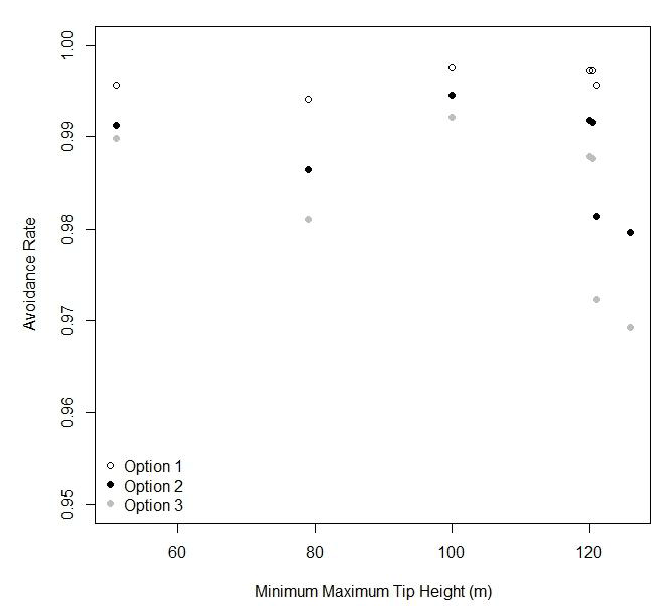
Figure 5.18 Impact of excluding sites with smaller turbines on the within-windfarm avoidance rates derived using ratio estimators for options 1, 2 and 3 of the Band model for large gulls.
Using option 1 of the Band model, there does not appear to be a relationship between turbine size and the within-windfarm avoidance rates derived using ratio estimators ( Figure 5.18). However, in the case of options 2 and 3, there is a trend for lower within-windfarm avoidance rates with larger turbines. This apparent discrepancy is likely to reflect differences between the proportion of birds observed flying at collision risk height and the proportion of birds estimated to fly at collision risk height from generic distributions. The generic distributions estimated a lower proportion of birds flying at collision risk height for the larger turbines, meaning the predicted collision rate, and therefore overall within-windfarm avoidance rate, was reduced.
We consider within-windfarm avoidance rates of 0.9956 (±0.0004 SD) for the basic Band model, and 0.9898 (±0.0009 SD) for the extended Band model to be realistic, precautionary values given the data available. Whilst we identified several sites as having a strong influence over the final values derived, we do not feel there is sufficient reason to exclude these data from our analysis. It should be noted that the influence of these sites occurs in similar magnitudes in both positive and negative directions. We did not identify any strong impact of turbine size on the final within-windfarm avoidance rate derived.
All gulls
A total of 2,567,124 gulls were expected to have passed through seven sites over the course of their respective study periods. After adjustments were made to this total to account for the proportion of birds flying at rotor height, the size of the rotor swept area and the probability of birds passing through the rotor-swept area without colliding, this was predicted to result in 10,052 collisions based on option 1, 4,054 collisions based on option 2, and 3,271 based on option 3. However, in total only 107 gull collisions were recorded across all sites during their respective study periods. This corresponds to within-windfarm avoidance rates of 0.9893 (±0.0007 SD) using option 1 of the Band model, 0.9735 (±0.0014 SD) using option 2 of the Band model and 0.9672 (±0.0018 SD) using option 3 of the Band model.
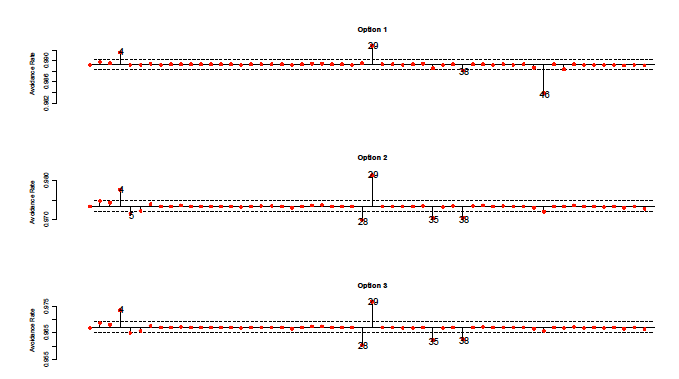
Figure 5.19 Leverage exerted by each site at which within-windfarm avoidance rates were calculated on the overall, mean within-windfarm avoidance rate derived for all gulls. Solid line indicates mean within-windfarm avoidance rate across all sites, broken line indicates mean within-windfarm avoidance rate across all sites ± 1 standard deviation, dots indicate mean within-windfarm avoidance rate with each site excluded from analysis. Sites are considered to have high leverage when their exclusion from the analysis leads to a change of more than 1 standard deviation in the overall mean within-windfarm avoidance rate. Sites with high leverage are 4 - black-headed gulls, Bouin; 5 - gull spp, Bouin; 28 - gull spp, Oosterbierum (autumn 1990); 29 - gull spp , Oosterbierum (spring 1991); 35 - herring gull, Zeebrugge (September-October 2001); 38 - lesser black-backed gull in Zeebrugge (September-October 2001); 46 - common gull, Hellrigg (2012/13).
For all three model options, excluding data for black-headed gulls at Bouin and gull spp at Oosterbierum in autumn 1990, results in an increase in the overall within-windfarm avoidance in the final derived within-windfarm avoidance rates (Figure 5.19). There are no obvious commonalities between these sites. The turbines at Oosterbierum are relatively small with a maximum tip height of 50 m, but those at Bouin are more typical of the sites in our study, with maximum tip heights of 100 m. Using option 1, the exclusion of data from lesser black-backed gull at Zeebrugge in September-October 2001 and common gull at Hellrigg in 2012/13 resulted in decreased within-windfarm avoidance rates. This is likely to reflect relatively high levels of bird activity in combination with very few recorded collisions at these sites, meaning they have a negative bias on the final, derived figures. This pattern was repeated for gull spp at Oosterbierum in spring 1991 and herring gulls and lesser black-backed gulls at Zeebrugge in September-October 2001 using options 2 and 3 and gull spp at Bouin using option 2.
It should be noted that for all three model options, leverage occurred in both directions. We did not feel there was a valid justification for excluding any of these data points from our analysis.
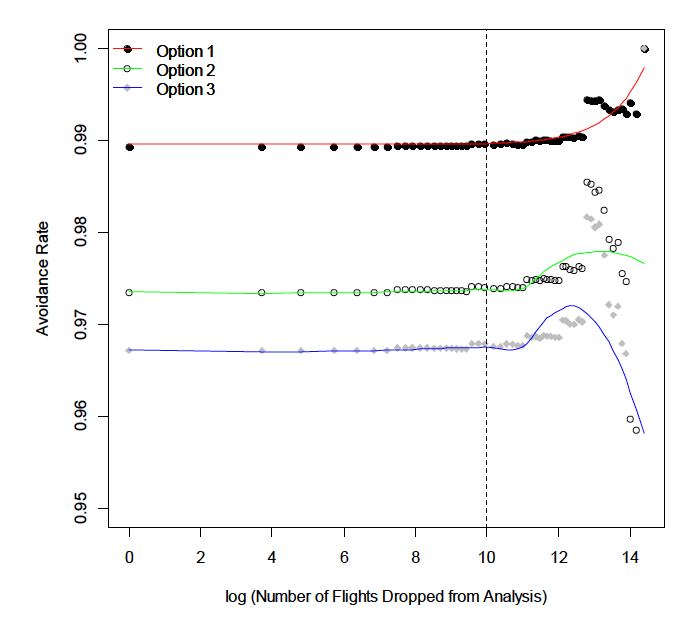
Figure 5.20 Impact of dropping data points (each site-year-species combination) on the within-windfarm avoidance rates derived using ratio estimators for options 1, 2 and 3 of the Band model.
As might be expected, dropping sites from the analysis can influence the final within-windfarm avoidance rates. Only sites at which there is a relatively limited level of flight activity can be dropped from the analysis before the within-windfarm avoidance rates derived become less stable ( Figure 5.20). In all three model options, this is noticeable after around 22,000 of the 2,605,681 flights through the windfarms have been removed ( Figure 5.20).
Using option 1 of the Band model, dropping sites from the analysis results in an increase in the overall within-windfarm avoidance. This result suggests that, for option 1, a higher flux rate is associated with a higher within-windfarm avoidance rate. Collisions between birds and turbines are relatively rare events, so studies carried out over a month or two may under-estimate mean annual within-windfarm avoidance rates if they are targeted to specific times of year when collisions are more likely. Amongst our datasets, there was a propensity for studies carried out during the breeding season. At Zeebrugge, both herring and lesser black-backed gulls showed a marked increase in their within-windfarm avoidance rates during the autumn than during the breeding season. At present, data are not robust enough to enable detailed analysis of seasonal patterns in within-windfarm avoidance behaviour, but this is an area that would benefit from such analyses as better data become available.
Initially a similar pattern is evident with option 3 of the Band model. However, when only the last few sites are included in the analysis, the final within-windfarm avoidance rates derived using ratio estimators start to fall ( Figure 5.20). The decline is driven by breeding season data from Zeebrugge and Bouin, sites where turbines are situated close to the edge of breeding colonies. The reason the pattern is not evident in the within-windfarm avoidance rates derived using option 1 is the variation in the difference between the proportion of birds observed at rotor height in each study and those predicted to occur at rotor height based on the modelled flight height distribution. This is apparent when the differences between within-windfarm avoidance rates derived using options 1 and 2 are considered. Options 1 and 2 differ only in the proportion of birds predicted to fly at collision risk height. The proportion of birds estimated to fly at rotor height tended to be lower than the proportion of birds observed flying at rotor height ( Appendix 7). As a result, the predicted collision rate, and therefore mean within-windfarm avoidance rate, was lower using option 2 than option 1. This difference becomes exaggerated under option 3 because, in addition to accounting for a lower proportion of birds flying at rotor height, fewer of these birds are predicted to collide.
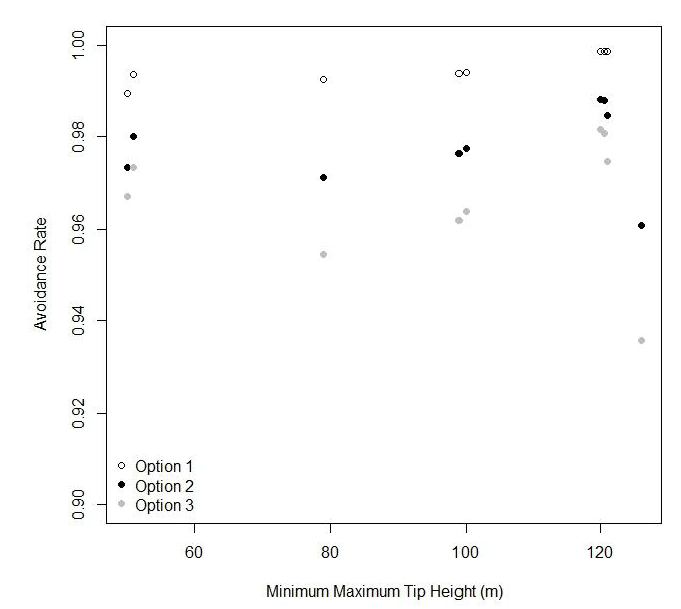
Figure 5.21 Impact of excluding sites with smaller turbines on the within-windfarm avoidance rates derived using ratio estimators for options 1, 2 and 3 of the Band model for large gulls.
Across all three model options there did not appear to be any consistent effect of excluding data collected from sites with smaller turbines on the final within-windfarm avoidance rates derived ( Figure 5.21).
We consider that within-windfarm avoidance rates of 0.9893 (±0.0007 SD) for the basic Band model and 0.9672 (±0.0018 SD) for the extended Band model are realistic precautionary within-windfarm avoidance rates given the data available. Whilst we identified several sites as having a strong influence over the final values derived, we do not feel there is sufficient reason to exclude these data from our analysis. It should be noted that the influence of these sites occurs in similar magnitudes in both positive and negative directions. We did not identify any strong impact of turbine size on the final within-windfarm avoidance rate derived.
All terns
A total of 1,286,562 terns were expected to have passed through one site - Zeebrugge - during June 2004 and June 2005. After adjustments were made to this total to account for the proportion of birds flying at rotor height, the size of the rotor swept area and the probability of birds passing through the rotor-swept area without colliding, this was predicted to result in 1,408 collisions based on option 1, 1,299 collisions based on option 2, and 1,011 based on option 3. However, in total only 21 tern collisions were recorded across all sites during their respective study periods. This corresponds to within-windfarm avoidance rates of 0.9851 (±0.0022 SD) using option 1 of the Band model, 0.9838 (±0.0031 SD) using option 2 of the Band model and 0.9792 (±0.0040 SD) using option 3 of the Band model.
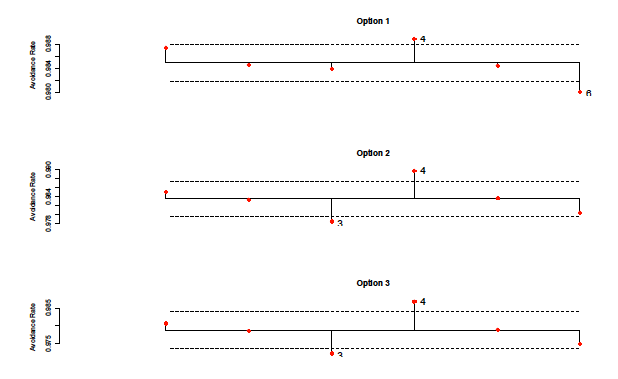
Figure 5.22 Leverage exerted by each site at which within-windfarm avoidance rates were calculated on the overall, mean within-windfarm avoidance rate derived for terns. Solid line indicates mean within-windfarm avoidance rate across all sites, broken line indicates mean within-windfarm avoidance rate across all sites ± 1 standard deviation, dots indicate mean within-windfarm avoidance rate with each site excluded from analysis. Sites are considered to have high leverage when their exclusion from the analysis leads to a change of more than 1 standard deviation in the overall mean within-windfarm avoidance rate. Points with high leverage are 3 - Sandwich tern in June 2004, 4 - common tern in June 2005, 6 - Sandwich tern in June 2005.
There was no obvious pattern in the data points with high leverage. Using all three model options, excluding common tern data from June 2005 was found to result in an increased within-windfarm avoidance rate, reflecting the relatively high collision rate involving this species in this year ( Figure 5.22). Using option 1, excluding Sandwich tern data from June 2005 resulted in a decrease in the within-windfarm avoidance rate derived. Using options 2 and 3 the same was true of Sandwich tern data in June 2004. This is likely to reflect the fact that relatively few collisions were recorded involving this species, despite a high flux rate. Differences between model options are likely to result from differences between the proportion of birds observed at collision risk height during surveys, and that estimated from the modelled distributions. We do not consider there to be a valid reason to exclude any of these data from our analysis when deriving within-windfarm avoidance rates.
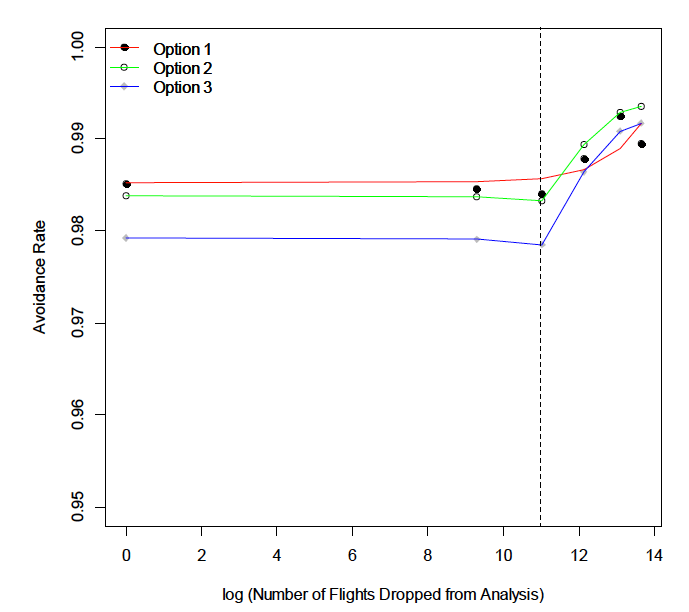
Figure 5.23 Impact of dropping data points (each year-species combination) on the within-windfarm avoidance rates derived using ratio estimators for options 1, 2 and 3 of the Band model for terns.
Within-windfarm avoidance rates derived using all three model options remain relatively stable as the first 660,000 flights through windfarms are dropped from the analysis ( Figure 5.23), before increasing as only the species with the highest levels of activity remain. This reflects the fact that Sandwich terns, the species with the highest levels of activity were involved in relatively few collisions, resulting in an overall increase in the within-windfarm avoidance rates as other species were dropped from the analysis.
We consider that within-windfarm avoidance rates of 0.9851 (±0.0022 SD) for the basic Band model and 0.9792 (±0.0040 SD) for the extended Band model are realistic precautionary within-windfarm avoidance rates given the data available. Whilst we determined that some data points had a high level of leverage on the final values derived, we did not feel that there was sufficient justification for excluding them from our analysis. It should be noted that this leverage occurred in both positive and negative directions. However, as data come from only a single site, it is unclear how transferable they are to novel sites.
Contact
There is a problem
Thanks for your feedback